A regularly updated selection of silent films that can be watched for free on-line.
( NB. Most of the films we list here are provided legitimately on-line by distribution companies, film archives and rights holders but one or two are less ‘official’ postings. Although the films may have been made a century ago distributors, archives and accompanists still need to earn a crust, particularly in these desperate times, so if there is anything here that you like it will almost certainly look better if you buy and watch it on disc or pay to see it ‘live’ on the big screen, so get out and contribute a few pounds/dollars/Euros/whatever towards the future of silent film.)
11 November
 Love or Justice? (aka The Woman of It) (Dir. Walter Edwards, US, 1917). (63mins at 18fps) Jack Dunn (Jack Richardson), a once promising young lawyer who is now addicted to drugs, spends his time in The Dolphin. a club frequented by criminals. Here he attracts the attention of Nan Bishop (Louise Glaum), an underworld figure and there is an instant mutual atraction. Nan helps Jack kick his drug habit and, unbeknownst to him, is instrumental in his getting a job in the DA’s office. But in the process she sacrifices their relationship and disappears from Jack’s life. Much later, when Nan is framed for the murder of a police detective and facing trial, Jack is the prosecuting attorney and his professional future depends on winning the case! Love or Justice is a surprisingly little known film from producer Thomas Ince. The story was an early effort by journalist Lambert Hillyer who would go on to a long, if not particularly prestigious, career as screenwriter and director. Louise Glaum is excellent as Nan although Jack Richardson is a somewhat wooden male lead. Although the film’s plotting eventually crosses the threshold into absurdity particularly with the final court scene, it remains eminently watchable and there is a fleeting appearance as Benny the pick-pocket by Jack Gilbert, who would go on to much greater fame when he changed his name to John!. A nicely restored version of the film (albeit with some nitrate damage) comes from the Eastman Film Museum and can be watched here. Sadly it does not come with musical accompaniment.
Love or Justice? (aka The Woman of It) (Dir. Walter Edwards, US, 1917). (63mins at 18fps) Jack Dunn (Jack Richardson), a once promising young lawyer who is now addicted to drugs, spends his time in The Dolphin. a club frequented by criminals. Here he attracts the attention of Nan Bishop (Louise Glaum), an underworld figure and there is an instant mutual atraction. Nan helps Jack kick his drug habit and, unbeknownst to him, is instrumental in his getting a job in the DA’s office. But in the process she sacrifices their relationship and disappears from Jack’s life. Much later, when Nan is framed for the murder of a police detective and facing trial, Jack is the prosecuting attorney and his professional future depends on winning the case! Love or Justice is a surprisingly little known film from producer Thomas Ince. The story was an early effort by journalist Lambert Hillyer who would go on to a long, if not particularly prestigious, career as screenwriter and director. Louise Glaum is excellent as Nan although Jack Richardson is a somewhat wooden male lead. Although the film’s plotting eventually crosses the threshold into absurdity particularly with the final court scene, it remains eminently watchable and there is a fleeting appearance as Benny the pick-pocket by Jack Gilbert, who would go on to much greater fame when he changed his name to John!. A nicely restored version of the film (albeit with some nitrate damage) comes from the Eastman Film Museum and can be watched here. Sadly it does not come with musical accompaniment.
22 August
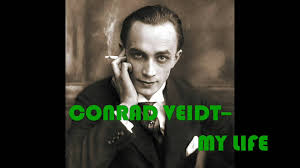 Conrad Veigt – My Life (Dir. Mark Rappaport, UK, 2019) Conrad Veidt is perhaps best known for his regular roles in his later American films as a suave and sinister Nazi, most notably Major Heinrich Strasser, in Casablanca. In reality, his career dates back to 1917 and the silent era where he played in a number of seminal German impressionistic films. Using clips from Veidt’s films, acclaimed director Mark Rappaport imagines the actor narrating his life and career from the silent era—including his leading roles in The Cabinet of Dr. Caligari and The Man Who Laughs (which inspired the character of The Joker)—through to his Hollywood years where, with supreme irony, he often played a Nazi, while in reality he was an ardent anti-fascist who left Nazi Germany for Britain, falsely claiming to be Jewish in solidarity with his Jewish wife. Until the end of August, the film is available to watch for free from Filmmuseum Munchen on Vimeo here
Conrad Veigt – My Life (Dir. Mark Rappaport, UK, 2019) Conrad Veidt is perhaps best known for his regular roles in his later American films as a suave and sinister Nazi, most notably Major Heinrich Strasser, in Casablanca. In reality, his career dates back to 1917 and the silent era where he played in a number of seminal German impressionistic films. Using clips from Veidt’s films, acclaimed director Mark Rappaport imagines the actor narrating his life and career from the silent era—including his leading roles in The Cabinet of Dr. Caligari and The Man Who Laughs (which inspired the character of The Joker)—through to his Hollywood years where, with supreme irony, he often played a Nazi, while in reality he was an ardent anti-fascist who left Nazi Germany for Britain, falsely claiming to be Jewish in solidarity with his Jewish wife. Until the end of August, the film is available to watch for free from Filmmuseum Munchen on Vimeo here
20 August
 When The Earth Trembled (Dir. Barry O’Neil, US, 1913). This short feature, centered around the 1906 San Francisco earthquake, is a master class in just how much drama and action you can pack into just 43 minutes of nitrate. Including family feuds, business machinations, shipwreck and castaway rescue, and final melodramatic reconciliation, the actual earthquake itself seems at times just a minor sub-plot. But
When The Earth Trembled (Dir. Barry O’Neil, US, 1913). This short feature, centered around the 1906 San Francisco earthquake, is a master class in just how much drama and action you can pack into just 43 minutes of nitrate. Including family feuds, business machinations, shipwreck and castaway rescue, and final melodramatic reconciliation, the actual earthquake itself seems at times just a minor sub-plot. But  when the earth does tremble, it is indeed dramatic stuff. Production company Lubin Studio were turning out two films a week at the time but devoted an at-that-time unheard of four months to complete the film and its special effects. And full marks go to star Ethyl Clayton who steadfastly carries on in one scene despite being accidently being hit full in the face by a falling chandilier. The film was superbly restored by Robert Byrne for the San Francisco Silent Film Festival where it was screened in 2015 and it can be viewed on the SFSFF webpage on Vimeo here with the same live accompaniment from Stephen Horne and Frank Bockius recorded on that occasion.
when the earth does tremble, it is indeed dramatic stuff. Production company Lubin Studio were turning out two films a week at the time but devoted an at-that-time unheard of four months to complete the film and its special effects. And full marks go to star Ethyl Clayton who steadfastly carries on in one scene despite being accidently being hit full in the face by a falling chandilier. The film was superbly restored by Robert Byrne for the San Francisco Silent Film Festival where it was screened in 2015 and it can be viewed on the SFSFF webpage on Vimeo here with the same live accompaniment from Stephen Horne and Frank Bockius recorded on that occasion.
31 July
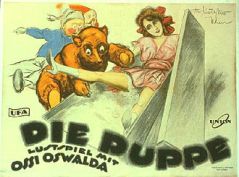 The Doll (Die Puppe) (Dir. Ernst Lubitsch, Ger, 1919) (70mins) Another early classic from director Lubitisch, right from opening shots as the director himself appears to build the highly stylised set from a giant toy box. And when the set comes to life we find the rich Baron trying to find a bride for his milksop nephew. To avoid marrying a real girl, the shy nephew arranges for a toymaker to
The Doll (Die Puppe) (Dir. Ernst Lubitsch, Ger, 1919) (70mins) Another early classic from director Lubitisch, right from opening shots as the director himself appears to build the highly stylised set from a giant toy box. And when the set comes to life we find the rich Baron trying to find a bride for his milksop nephew. To avoid marrying a real girl, the shy nephew arranges for a toymaker to  secretly make him a life-sized doll he can marry instead. But when the doll is accidentally broken, the toy-maker’s daughter surrepticiously takes its place and mayhem ensues. This was another Lubitsch film where the entire cast were clearly having a great time, particularly Ossi Oswalda, playing both the girl and the doll. The whole film is not just very funny but also hugely innovative with just the most sublime slice of risque humour from Lubitsch, already finding his famous ‘touch’. Find out more at moviessilently.com The version here on You Tube is a beautiful restoration from Kino Lorber with a lovely score by Jon Mirsalis. The film is available to buy on disc either individually or as part of the Lubitsch In Berlin box set from Eureka.
secretly make him a life-sized doll he can marry instead. But when the doll is accidentally broken, the toy-maker’s daughter surrepticiously takes its place and mayhem ensues. This was another Lubitsch film where the entire cast were clearly having a great time, particularly Ossi Oswalda, playing both the girl and the doll. The whole film is not just very funny but also hugely innovative with just the most sublime slice of risque humour from Lubitsch, already finding his famous ‘touch’. Find out more at moviessilently.com The version here on You Tube is a beautiful restoration from Kino Lorber with a lovely score by Jon Mirsalis. The film is available to buy on disc either individually or as part of the Lubitsch In Berlin box set from Eureka.
30 July
 Rob Roy (Dir. William Kellino, UK, 1922) (80mins) Rarely screened, this early biopic of one of Scotland’s best-known outlaws stars David Hawthorne in full tartan kilt and tammy and tells the story of the MacGregors in the early 18th century. Shot entirely on location in the Trossachs and nearby Stirling Castle, whilst the 10th Duke of Argyll gave permission to the production to film on his estates, the film makes liberal use of Scots for the intertitles (“dinnae fash yersel”) and includes epic fight scenes, with over 800 men of the Argyll and Sutherland Highlanders enlisted as extras in
Rob Roy (Dir. William Kellino, UK, 1922) (80mins) Rarely screened, this early biopic of one of Scotland’s best-known outlaws stars David Hawthorne in full tartan kilt and tammy and tells the story of the MacGregors in the early 18th century. Shot entirely on location in the Trossachs and nearby Stirling Castle, whilst the 10th Duke of Argyll gave permission to the production to film on his estates, the film makes liberal use of Scots for the intertitles (“dinnae fash yersel”) and includes epic fight scenes, with over 800 men of the Argyll and Sutherland Highlanders enlisted as extras in  a dramatic battle. Although perhaps not a classic, it does have some memorable scenes, with the dramatic night-time shots of the burning down of the MacGregor clan’s ‘s crofts a particular highlight. It is also a film of some impressive facial hair with not only Rob Roy’s awesome monobrow but also the aptly named Sandy The Biter, looking like a real-life incarnation of Yosemite Sam and someone whose behavior amply lived up to his moniker. Find out more at imdb.com The film can be viewed on the BFI‘s You Tube channel here. This version comes without musical accompaniment. However, acclaimed musician David Allison was commissioned to compose a new score for the film at last years HippFest and he has just put the score out on Spotify here. So, with a bit of judicious button pressing it is just about possible to stream both the film and the music in tandem and they complement each other beautifully. Other than a couple other versions of the film on You Tube there is no sign of Rob Roy being available on disc.
a dramatic battle. Although perhaps not a classic, it does have some memorable scenes, with the dramatic night-time shots of the burning down of the MacGregor clan’s ‘s crofts a particular highlight. It is also a film of some impressive facial hair with not only Rob Roy’s awesome monobrow but also the aptly named Sandy The Biter, looking like a real-life incarnation of Yosemite Sam and someone whose behavior amply lived up to his moniker. Find out more at imdb.com The film can be viewed on the BFI‘s You Tube channel here. This version comes without musical accompaniment. However, acclaimed musician David Allison was commissioned to compose a new score for the film at last years HippFest and he has just put the score out on Spotify here. So, with a bit of judicious button pressing it is just about possible to stream both the film and the music in tandem and they complement each other beautifully. Other than a couple other versions of the film on You Tube there is no sign of Rob Roy being available on disc.
19 June
 Queen Of Hearts (Dir. Yakov Protazanov, Russis, 1916) (84 mins) A young but impoverished Russian nobleman, German (Ivan Mozzhukhin), is fascinated by his friend’s constant gambling at cards but when invited to join them in a game replies “I am not in a position to risk the essential in the hope of acquiring the superfluous.” But when he learns of an old countess who supposedly has
Queen Of Hearts (Dir. Yakov Protazanov, Russis, 1916) (84 mins) A young but impoverished Russian nobleman, German (Ivan Mozzhukhin), is fascinated by his friend’s constant gambling at cards but when invited to join them in a game replies “I am not in a position to risk the essential in the hope of acquiring the superfluous.” But when he learns of an old countess who supposedly has  knowledge of a card system which means she will always win he becomes obsessed with learning the secret for himself. He schemes to gain access to the countess via her young niece Lizaveta (Vera Orlova). But will the secret bring him the fortune he desires or will it prove his undoing? Based upon the 1834 short story by Alexander Pushkin, Queen Of Hearts had been filmed previously in 1910 by Russian director Pyotr Chardynin. However, this 1916 version probably represents one of the crowning achievements of pre-revolutionary Russian cinema. It may be a relatively simple tale of the supernatural but what stands out are the impressive production values (sets, costumes, cast numbers etc) as well as some novel early cinematic techniques (such as the split sreening, double exposures and the story-within-a-story narrative). Ivan Mozzhukhin puts in his usual broodingly
knowledge of a card system which means she will always win he becomes obsessed with learning the secret for himself. He schemes to gain access to the countess via her young niece Lizaveta (Vera Orlova). But will the secret bring him the fortune he desires or will it prove his undoing? Based upon the 1834 short story by Alexander Pushkin, Queen Of Hearts had been filmed previously in 1910 by Russian director Pyotr Chardynin. However, this 1916 version probably represents one of the crowning achievements of pre-revolutionary Russian cinema. It may be a relatively simple tale of the supernatural but what stands out are the impressive production values (sets, costumes, cast numbers etc) as well as some novel early cinematic techniques (such as the split sreening, double exposures and the story-within-a-story narrative). Ivan Mozzhukhin puts in his usual broodingly 
 intense performance while Tamara Duvan is interesting as the young countess (although the overuse of eye-liner amongst all the cast does at times prove somewhat distracting!). Mozzhukhin would leave Russia come the revolution, never to return but enjoying cosiderable success in France as Ivan Ivan Mosjoukine. Protazanov would also leave Russia but he returned in the early 1920s and resumed directorial work, most notably with the pioneering science fiction film Aelita: Queen of Mars (1924). Find out more at thedevilsmanor.blogspot.com. The version here on You Tube is of OK quality and comes with musical accompaniment. The film is available to buy from Milestone as part of their Early Russian Cinema anthology here
intense performance while Tamara Duvan is interesting as the young countess (although the overuse of eye-liner amongst all the cast does at times prove somewhat distracting!). Mozzhukhin would leave Russia come the revolution, never to return but enjoying cosiderable success in France as Ivan Ivan Mosjoukine. Protazanov would also leave Russia but he returned in the early 1920s and resumed directorial work, most notably with the pioneering science fiction film Aelita: Queen of Mars (1924). Find out more at thedevilsmanor.blogspot.com. The version here on You Tube is of OK quality and comes with musical accompaniment. The film is available to buy from Milestone as part of their Early Russian Cinema anthology here
18 June
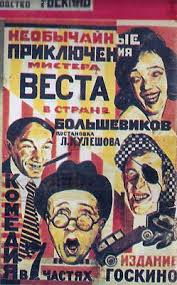 The Extraordinary Adventures of Mr. West in the Land of the Bolsheviks (Dir. Lev Kuleshov, USSR, 1924) (94 mins). As Mr. West, the president of the American YMCA, prepares to journey to the Soviet Union in the hope of establishing a YMCA branch YMCA there, US newspapers warn of a land of criminality and unrest,
The Extraordinary Adventures of Mr. West in the Land of the Bolsheviks (Dir. Lev Kuleshov, USSR, 1924) (94 mins). As Mr. West, the president of the American YMCA, prepares to journey to the Soviet Union in the hope of establishing a YMCA branch YMCA there, US newspapers warn of a land of criminality and unrest,  populated by fur-wearing Bolshevik savages. For his protection Mr West decides to take along Jeddy, his gun toting cowboy employee. But soon after arriving in Moscow, Mr West’s briefcase is stolen and he becomes separated from Jeddy. But worse is to follow when he falls into the hands of an apparently ruthless gang who appear to confirm his worst stereotypes of the savage Bolshevik. The Extraordinary Adventures of Mr. West…. was the first feature length production from director Lev Kuleshov‘s radical and innovative cinematic ‘workshop’. At one level it is a riotous and very funny comedy amply demonstrating all that the workshop had gleamed from the work of American directors such as Sennett and Griffith with its rapid and cross-cutting. It is surely no coincidence that the central character of Mr West is a Harold Lloyd look-alike. But the film also showcases how
populated by fur-wearing Bolshevik savages. For his protection Mr West decides to take along Jeddy, his gun toting cowboy employee. But soon after arriving in Moscow, Mr West’s briefcase is stolen and he becomes separated from Jeddy. But worse is to follow when he falls into the hands of an apparently ruthless gang who appear to confirm his worst stereotypes of the savage Bolshevik. The Extraordinary Adventures of Mr. West…. was the first feature length production from director Lev Kuleshov‘s radical and innovative cinematic ‘workshop’. At one level it is a riotous and very funny comedy amply demonstrating all that the workshop had gleamed from the work of American directors such as Sennett and Griffith with its rapid and cross-cutting. It is surely no coincidence that the central character of Mr West is a Harold Lloyd look-alike. But the film also showcases how  Kuleshov had taken this work forward with his own brand of montage, criss-crossing between various plot threads at an increasing pace. At another leval, the film is also a piece of cinematic propaganda intended to highlight (deliberate?) American misconceptions about the impact of the Bolshevik
Kuleshov had taken this work forward with his own brand of montage, criss-crossing between various plot threads at an increasing pace. At another leval, the film is also a piece of cinematic propaganda intended to highlight (deliberate?) American misconceptions about the impact of the Bolshevik 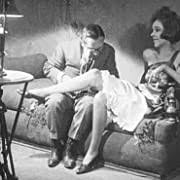 revolution. The film’s cast and crew are a veritable Who’s Who of the early Soviet film talent. Actors Boris Barnet and Vsevolod Pudovkin both went on to become renowned directors (for example, Girl With A Hatbox (1927) and Mother (1926) respectively). Actress Aleksandra Khokhlova is perhaps best known for her role in By The Law (1926) but also went on to direct. Although Kuleshov himself continued to work in various aspects of the Soviet film industry until his death in 1970 his frequent brushes with the authorities meant that he never achieved the heights his early work foretold. However, his impact as a mentor for the likes of Barnet and Pudovkin as well as Eisenstein, Dovzhenko and Vertov can never be under-estimated. Find out more at sensesofcinema.com. There is a nice version of the film here on You Tube courtesy of All Soviet Movies on RVISION with a pleasant piano and strings accompaniment. The film was available to buy on Flicker Alley‘s compendium Landmarks of Early Soviet Films although it currently appears out of stock. The only other alternative appears to be a French import with just Russian/French inter-titles here
revolution. The film’s cast and crew are a veritable Who’s Who of the early Soviet film talent. Actors Boris Barnet and Vsevolod Pudovkin both went on to become renowned directors (for example, Girl With A Hatbox (1927) and Mother (1926) respectively). Actress Aleksandra Khokhlova is perhaps best known for her role in By The Law (1926) but also went on to direct. Although Kuleshov himself continued to work in various aspects of the Soviet film industry until his death in 1970 his frequent brushes with the authorities meant that he never achieved the heights his early work foretold. However, his impact as a mentor for the likes of Barnet and Pudovkin as well as Eisenstein, Dovzhenko and Vertov can never be under-estimated. Find out more at sensesofcinema.com. There is a nice version of the film here on You Tube courtesy of All Soviet Movies on RVISION with a pleasant piano and strings accompaniment. The film was available to buy on Flicker Alley‘s compendium Landmarks of Early Soviet Films although it currently appears out of stock. The only other alternative appears to be a French import with just Russian/French inter-titles here
12 June
 An Old Gangster’s Moll (aka Milenky staré kriminálníka aka The Lovers of an Old Criminal) (Dir. Svatopluk Innemann, Cz, 1927) (108 mins) Factory owner Pardon (Jan W. Speerger) meets Olga and the two hit it off right away. But Olga’s mother breaks them up
An Old Gangster’s Moll (aka Milenky staré kriminálníka aka The Lovers of an Old Criminal) (Dir. Svatopluk Innemann, Cz, 1927) (108 mins) Factory owner Pardon (Jan W. Speerger) meets Olga and the two hit it off right away. But Olga’s mother breaks them up  seeking a better match for her daughter. Meanwhile a rich businessman is pressurising Pardon to marry his eccentric daughter Fifi (Anny Ondráková). But Pardon has eyes only for Olga so he gets his aged uncle Cyril ( Vlasta Burian) to impersonate himself in the hope of putting Fifi off. But Fifi is not a girl to be put off so easily, even when Cyril pretends to be the notorious murderer Kanibal. But then the real Kanibal also shows up…. An Old Gangster’s Moll is nothing if not complicated. But it is also an hilarious knock-about comedy. Anny Ondráková (who became Anny Ondra when she moved to Britain to star in
seeking a better match for her daughter. Meanwhile a rich businessman is pressurising Pardon to marry his eccentric daughter Fifi (Anny Ondráková). But Pardon has eyes only for Olga so he gets his aged uncle Cyril ( Vlasta Burian) to impersonate himself in the hope of putting Fifi off. But Fifi is not a girl to be put off so easily, even when Cyril pretends to be the notorious murderer Kanibal. But then the real Kanibal also shows up…. An Old Gangster’s Moll is nothing if not complicated. But it is also an hilarious knock-about comedy. Anny Ondráková (who became Anny Ondra when she moved to Britain to star in 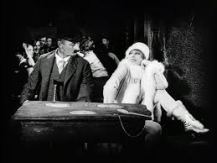 Hitchcock thrillers) is fantastic as the mini-skirt wearing, cigar-chomping Fifi. Unknown in the West but still to this day a comedy legend in the Czech Republic, Vlasta Burian is also excellent as Uncle Cyril. The film maintains a frenetic pace throughout with frequent laugh-out-loud moments, I cannot recommend it too highly. Check out our (with spoilers) review here. Find out more at ithankyouarthur.blogspot.com. There is a good quality version of the film here with an interesting musical accompaniment curteosy of the Czech National Film Archive fro whom the film can also be purchased here via Amazon.
Hitchcock thrillers) is fantastic as the mini-skirt wearing, cigar-chomping Fifi. Unknown in the West but still to this day a comedy legend in the Czech Republic, Vlasta Burian is also excellent as Uncle Cyril. The film maintains a frenetic pace throughout with frequent laugh-out-loud moments, I cannot recommend it too highly. Check out our (with spoilers) review here. Find out more at ithankyouarthur.blogspot.com. There is a good quality version of the film here with an interesting musical accompaniment curteosy of the Czech National Film Archive fro whom the film can also be purchased here via Amazon.
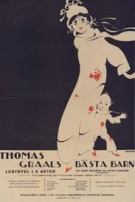 Thomas Graal’s Best Child (Dir. Mauritz Stiller, Swe, 1918) (72 mins) When Thomas Graal (Victor Sjostrom)’s new wife Bessie (Karin Molander) says on their wedding day that she ‘knows’ that their first child will be a girl, Thomas is somewhat shocked as he had
Thomas Graal’s Best Child (Dir. Mauritz Stiller, Swe, 1918) (72 mins) When Thomas Graal (Victor Sjostrom)’s new wife Bessie (Karin Molander) says on their wedding day that she ‘knows’ that their first child will be a girl, Thomas is somewhat shocked as he had 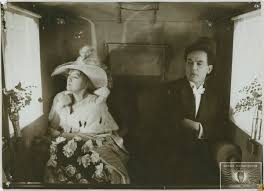 always anticipated having a son. Wedding day feuding turns to longer drawn out marital strife until a passing drunk provides the impetus for a reconciliation but what then when the first child comes along? Thomas Graal’s Best Child was a sort of sequel to director Stiller’s earlier film Thomas Graal’s Best Film (1917), featuring the same leading players. As with the earlier film, it is a nice early example of the sophisticated battle-of-the-sexes marriage comedy. Indeed, some have drawn parellels between Sjostrom/Molander in the Thomas Graal films and the Powell/Loy pairing in the Thin Man series. Sjostrom of course went on to focus
always anticipated having a son. Wedding day feuding turns to longer drawn out marital strife until a passing drunk provides the impetus for a reconciliation but what then when the first child comes along? Thomas Graal’s Best Child was a sort of sequel to director Stiller’s earlier film Thomas Graal’s Best Film (1917), featuring the same leading players. As with the earlier film, it is a nice early example of the sophisticated battle-of-the-sexes marriage comedy. Indeed, some have drawn parellels between Sjostrom/Molander in the Thomas Graal films and the Powell/Loy pairing in the Thin Man series. Sjostrom of course went on to focus  more on directing (Phantom Carriage (1921), He Who Gets Slapped ( 1924), The Wind (1928) etc). As for Molander, despite rave reviews in this and other Stiller directed films her cinema career was all but over by 1920. She married Lars Hanson and went with him to Hollywood in the 1920s but after they returned to Sweden she had retired from even a theatrical acting career by the mid-1930s which was a shame as she clearly had considerable acting and comedic talent. Stiller too would get his chance in Hollywood but it was not a success and he returned to Sweden in 1927 where he died suddenly the following year aged just 45. Find out more at imdb.com. The version here on You Tube isn’t of great quality but it is just about watchable and comes with an OK musical accompaniment. The film is available to buy on disc here from Loving The Classics.
more on directing (Phantom Carriage (1921), He Who Gets Slapped ( 1924), The Wind (1928) etc). As for Molander, despite rave reviews in this and other Stiller directed films her cinema career was all but over by 1920. She married Lars Hanson and went with him to Hollywood in the 1920s but after they returned to Sweden she had retired from even a theatrical acting career by the mid-1930s which was a shame as she clearly had considerable acting and comedic talent. Stiller too would get his chance in Hollywood but it was not a success and he returned to Sweden in 1927 where he died suddenly the following year aged just 45. Find out more at imdb.com. The version here on You Tube isn’t of great quality but it is just about watchable and comes with an OK musical accompaniment. The film is available to buy on disc here from Loving The Classics.
11 June
 Dr Jekyll And Mr Hyde (Dir. John S. Robertson ,US, 1920) (79mins) This 1920 version was not the first cinematic retelling of Stevenson’s famous story but it remains one of the more memorable. John Barrymore is dignified and virtuous as Dr Henry Jekyll but when his friend, Sir George Carew (Brandon Hurst), takes him to a show featuring the sensual Miss Gina (Nita Naldi), an aroused Jekyll sets out on a quest to separate man’s saintly and
Dr Jekyll And Mr Hyde (Dir. John S. Robertson ,US, 1920) (79mins) This 1920 version was not the first cinematic retelling of Stevenson’s famous story but it remains one of the more memorable. John Barrymore is dignified and virtuous as Dr Henry Jekyll but when his friend, Sir George Carew (Brandon Hurst), takes him to a show featuring the sensual Miss Gina (Nita Naldi), an aroused Jekyll sets out on a quest to separate man’s saintly and  sinful sides. Barrymore’s classic transformation scenes, a mixture of facial and bodily contortions as well as make-up, are a sight to behold. But while he may capture the tortured soul of the doctor who has released the monster he can no longer control, Barrymore’s portrayl of Hyde tends to lurch onto over-
sinful sides. Barrymore’s classic transformation scenes, a mixture of facial and bodily contortions as well as make-up, are a sight to behold. But while he may capture the tortured soul of the doctor who has released the monster he can no longer control, Barrymore’s portrayl of Hyde tends to lurch onto over- dramatic theatricality. Martha Mansfield plays the overly pure and innocent sweetheart Millicent Carewe but it is Nita Naldi who has a juicier role as the long suffering dance-hall star who sets the Doctor’s passions aflame (apparently having been chosen by Barrymore himself for the role) . She would go on to much bigger things, starring alongside Valentino in Blood and Sand (1922) and the now lost A Sainted Devil (1924). Find out more at moviessilently.com There is a reasonable quality version here on You Tube with a piano/violin musical accompaniment. The film is available to buy on disc here.
dramatic theatricality. Martha Mansfield plays the overly pure and innocent sweetheart Millicent Carewe but it is Nita Naldi who has a juicier role as the long suffering dance-hall star who sets the Doctor’s passions aflame (apparently having been chosen by Barrymore himself for the role) . She would go on to much bigger things, starring alongside Valentino in Blood and Sand (1922) and the now lost A Sainted Devil (1924). Find out more at moviessilently.com There is a reasonable quality version here on You Tube with a piano/violin musical accompaniment. The film is available to buy on disc here.
 Der Steinerne Reiter (The Stone Rider) (Dir. Fritz Wendhausen, Germany 1923) (86mins) In a distant Teutonic village a cruel despot (Rudolf Klein-Rogge) demands the right of the first night with the bride of one of his vassals. When the bridegroom refuses there is a fight and the bride is accidentally killed. The bride’s sister (Lucie Mannheim) swears revenge on the despot but gradually begins to see him in a new light. However, the other villagers remain intent upon revenge. Although some of the rather sudden changes of pace in the film perhaps hint at missing footage, the really impressive aspect of The Stone Rider was the almost hyper-expressionist look of the costumes and sets. These were the work of artist Heinrich Heuser and art director Karl
Der Steinerne Reiter (The Stone Rider) (Dir. Fritz Wendhausen, Germany 1923) (86mins) In a distant Teutonic village a cruel despot (Rudolf Klein-Rogge) demands the right of the first night with the bride of one of his vassals. When the bridegroom refuses there is a fight and the bride is accidentally killed. The bride’s sister (Lucie Mannheim) swears revenge on the despot but gradually begins to see him in a new light. However, the other villagers remain intent upon revenge. Although some of the rather sudden changes of pace in the film perhaps hint at missing footage, the really impressive aspect of The Stone Rider was the almost hyper-expressionist look of the costumes and sets. These were the work of artist Heinrich Heuser and art director Karl  Volbrecht, the latter who would go on to work on a range of Fritz Lang films including Der Nibelungen (1924), Metropolis (1927) and Woman in the Moon (1929). In a further link with Lang, The Stone Rider was scripted by Thea von Harbou (then married to Lang and, perhaps a little awkwardly on set, also previously married to Klein-Rogge). She would go on to script numerous Lang films including Metropolis. Klein-Rogge was excellent as the baron, driven to live up to his evil reputation, almost against his better judgement. This was but one of his many roles as the villain in Lang films,
Volbrecht, the latter who would go on to work on a range of Fritz Lang films including Der Nibelungen (1924), Metropolis (1927) and Woman in the Moon (1929). In a further link with Lang, The Stone Rider was scripted by Thea von Harbou (then married to Lang and, perhaps a little awkwardly on set, also previously married to Klein-Rogge). She would go on to script numerous Lang films including Metropolis. Klein-Rogge was excellent as the baron, driven to live up to his evil reputation, almost against his better judgement. This was but one of his many roles as the villain in Lang films,  most memorably as the mad scientist Rotwang in Metropolis. Equally good was Lucie Mannheim as Hirtin, whose grim determination for revenge fades as she gets to know the baron and is then faced with the dilemma of betraying her
most memorably as the mad scientist Rotwang in Metropolis. Equally good was Lucie Mannheim as Hirtin, whose grim determination for revenge fades as she gets to know the baron and is then faced with the dilemma of betraying her  fellow villagers to engineer his escape. Although probably best remembered as Annabella Smith, the blond whose early death sets Robert Hanney off on his search for The 39 Steps (1935), Mannheim was also notable in G W Pabst’s debut feature The Treasure (1923). Of note also was the cinematography from Carl Hoffmann (also responsible for Variety (1925), Faust (1926) and The Wonderful Lies of Nina Petrovna (1929)) and Gunter Rittau (Metropolis (1927), Asphalt (1929) and The Blue Angel (1930)). Amongst many stunning scenes, one in particular stood out when the evil baron’s shadow falls across the peasant village as he approaches. Find out more at imdb.com. The version available here on You Tube isn’t of particularly good quality but it does come with a thunderously good orchestral score. There is no sign of The Stone Rider being available in disc, which is a shame as it deserves to be better known.
fellow villagers to engineer his escape. Although probably best remembered as Annabella Smith, the blond whose early death sets Robert Hanney off on his search for The 39 Steps (1935), Mannheim was also notable in G W Pabst’s debut feature The Treasure (1923). Of note also was the cinematography from Carl Hoffmann (also responsible for Variety (1925), Faust (1926) and The Wonderful Lies of Nina Petrovna (1929)) and Gunter Rittau (Metropolis (1927), Asphalt (1929) and The Blue Angel (1930)). Amongst many stunning scenes, one in particular stood out when the evil baron’s shadow falls across the peasant village as he approaches. Find out more at imdb.com. The version available here on You Tube isn’t of particularly good quality but it does come with a thunderously good orchestral score. There is no sign of The Stone Rider being available in disc, which is a shame as it deserves to be better known.
7 June
 The Black Pirate (Dir. Albert Parker, US, 1926) (94 mins) After pirates attack, rob and blow up a merchant ship the only survivors are a dying man and his son (Douglas Fairbanks). Washed up on a desert island the son meets the self same
The Black Pirate (Dir. Albert Parker, US, 1926) (94 mins) After pirates attack, rob and blow up a merchant ship the only survivors are a dying man and his son (Douglas Fairbanks). Washed up on a desert island the son meets the self same  pirates burying their loot. Masquerading as ‘The Black Pirate’ he defeats the pirate captain and joins the gang. Single-handedly leading the capture of another merchant ship. Rather than killing the crew he convinces the pirates to hold them to ransom. When a woman (Billie Love) is discovered on board he manages initially to save her from the clutches of the pirates. But these pirates are a fickle lot and soon The Black Pirate’s life is in danger again. Producer and star Douglas Fairbanks had sought to bring a pirate story to the screen ever since completion of The Mark Of Zorro (1920) but had convinced himself that it could only be made in colour. It was not until 1926 therefore that two-tone Technicolor film technology was
pirates burying their loot. Masquerading as ‘The Black Pirate’ he defeats the pirate captain and joins the gang. Single-handedly leading the capture of another merchant ship. Rather than killing the crew he convinces the pirates to hold them to ransom. When a woman (Billie Love) is discovered on board he manages initially to save her from the clutches of the pirates. But these pirates are a fickle lot and soon The Black Pirate’s life is in danger again. Producer and star Douglas Fairbanks had sought to bring a pirate story to the screen ever since completion of The Mark Of Zorro (1920) but had convinced himself that it could only be made in colour. It was not until 1926 therefore that two-tone Technicolor film technology was  sufficiently developed to enable shooting to begin. The resulting film, altnough beaten to the screen by several other well recieved
sufficiently developed to enable shooting to begin. The resulting film, altnough beaten to the screen by several other well recieved  pirate films such as The Sea Hawk and Captain Blood (both 1924) nevertheless established many of the rules for the subsequent pirate film genre. Its classic Fairbanks faire, heavy on the action (with some very impressive sword fight sequences, not to mention some incredible acrobatics in the ship’s rigging), a smattering of love interest, but never taking himself too seriously. Billie Dove is the said love interest but she isn’t called on to do much other than swoon occasionally. The two-tone red/green colouring still works pretty well, adding significantly to the film’s overall impact. Find out more at silentfilm.org. A good quality coloured version is here via You Tube with an exciting orchestral score. It is available to buy here from Kino Lorber but make sure you get the Deluxe Edition to ensure its the colour version.
pirate films such as The Sea Hawk and Captain Blood (both 1924) nevertheless established many of the rules for the subsequent pirate film genre. Its classic Fairbanks faire, heavy on the action (with some very impressive sword fight sequences, not to mention some incredible acrobatics in the ship’s rigging), a smattering of love interest, but never taking himself too seriously. Billie Dove is the said love interest but she isn’t called on to do much other than swoon occasionally. The two-tone red/green colouring still works pretty well, adding significantly to the film’s overall impact. Find out more at silentfilm.org. A good quality coloured version is here via You Tube with an exciting orchestral score. It is available to buy here from Kino Lorber but make sure you get the Deluxe Edition to ensure its the colour version.
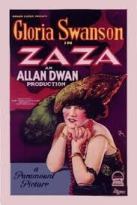 Zaza (Dir. Allan Dwan, US, 1923) (86 mins) The star of a provincial theatre near Paris is the tempestuous and firery tempered actress Zaza (Gloria Swanson). When diplomat
Zaza (Dir. Allan Dwan, US, 1923) (86 mins) The star of a provincial theatre near Paris is the tempestuous and firery tempered actress Zaza (Gloria Swanson). When diplomat 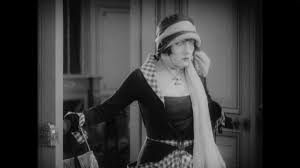 Bernard Dufresne (H.B. Warner) comes to the town on business and sees Zaza perform there is an immediate attraction between the two. But Zaza has a rival for Dufresne’s attractions, the theatre’s former star Florianne (Mary Thurman) who sabotages Zaza’s act. And Dufresne himself has a secret he’s not telling. Based upon a popular 1899 stage play of the same name by Pierre Berton and Charles Simon which had previously been filmed in 1915, director Allan Dwan brought the rights for Paramount, updated it and made it into a star vehicle for Gloria Swanson. Beautifully shot at Paramount’s Astoria Studios in New York and on location in a New Jersey mansion, the plot may be threadbare and the film
Bernard Dufresne (H.B. Warner) comes to the town on business and sees Zaza perform there is an immediate attraction between the two. But Zaza has a rival for Dufresne’s attractions, the theatre’s former star Florianne (Mary Thurman) who sabotages Zaza’s act. And Dufresne himself has a secret he’s not telling. Based upon a popular 1899 stage play of the same name by Pierre Berton and Charles Simon which had previously been filmed in 1915, director Allan Dwan brought the rights for Paramount, updated it and made it into a star vehicle for Gloria Swanson. Beautifully shot at Paramount’s Astoria Studios in New York and on location in a New Jersey mansion, the plot may be threadbare and the film  changes mid course from rom-com to melodrama but it certainly gave Swanson an opportunity to shine. And shine she does, in a series of
changes mid course from rom-com to melodrama but it certainly gave Swanson an opportunity to shine. And shine she does, in a series of  oppulent costumes, designer jewelry and extravagant hair styles, with everything embossed with her signature ‘Z’. The Dwan/Swanson combination worked so well that they went on to make a further seven films together while the film itself was remade again in 1939 with Claudette Colbert. Find out more at outofthepastblog.com. The version here on You Tube is of excellent quality with a nice piano accompaniment from Jeff Rapsis. The film is available to buy on BluRay and DVD from Kino Lorber here and includes audio commentary by author Frederic Lombardi and a 12-page insert booklet with promotional materials and an essay by Imogen Sara Smith.
oppulent costumes, designer jewelry and extravagant hair styles, with everything embossed with her signature ‘Z’. The Dwan/Swanson combination worked so well that they went on to make a further seven films together while the film itself was remade again in 1939 with Claudette Colbert. Find out more at outofthepastblog.com. The version here on You Tube is of excellent quality with a nice piano accompaniment from Jeff Rapsis. The film is available to buy on BluRay and DVD from Kino Lorber here and includes audio commentary by author Frederic Lombardi and a 12-page insert booklet with promotional materials and an essay by Imogen Sara Smith.
30 May
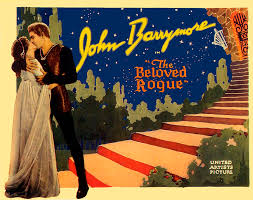 The Beloved Rogue (Dir. Alan Crosland, US, 1927) ( 98 mins) In fifteenth century France, Francois Villon (John Barrymore) is a poet, clown, womaniser, thief and vagabond. But above all he is a patriot ( who loves “France earnestly, Frenchwomen excessively, French wine exclusively”)
The Beloved Rogue (Dir. Alan Crosland, US, 1927) ( 98 mins) In fifteenth century France, Francois Villon (John Barrymore) is a poet, clown, womaniser, thief and vagabond. But above all he is a patriot ( who loves “France earnestly, Frenchwomen excessively, French wine exclusively”)  and is beloved by the downtrodden and working classes. As the Duke of Burgundy seeks to overthrow Louis XI (Conrad Veidt) and seize the throne by subterfuge, Villon thwarts his plans by spiriting away the King’s niece Charlotte de Vauxcelles (Marceline Day) who the Duke sought to marry off to one of his allies. But Villon is not yet in the clear with many a buckle yet to swash. While The Beloved Rogue owes little to historical accuracy it is nevertheless great fun. Barrymore plays hero Villon very much in the style of Douglas Fairbanks and looked to having great fun. But at a review screening he was
and is beloved by the downtrodden and working classes. As the Duke of Burgundy seeks to overthrow Louis XI (Conrad Veidt) and seize the throne by subterfuge, Villon thwarts his plans by spiriting away the King’s niece Charlotte de Vauxcelles (Marceline Day) who the Duke sought to marry off to one of his allies. But Villon is not yet in the clear with many a buckle yet to swash. While The Beloved Rogue owes little to historical accuracy it is nevertheless great fun. Barrymore plays hero Villon very much in the style of Douglas Fairbanks and looked to having great fun. But at a review screening he was reportedly horrified at his portrayal, crying out “Call yourself an actor? My god, what a ham!” Conrad Veidt, making his US debut, played the hugely
reportedly horrified at his portrayal, crying out “Call yourself an actor? My god, what a ham!” Conrad Veidt, making his US debut, played the hugely  superstitious King in the style more akin to a demented Richard III. Marceline Day looked wonderful but wasn’t called on to do a great deal beyond simpering. Also deserving of praise were the stunning set designs from William Cameron Menzies who had previously worked with Fairbanks on such classics as The Three Musketeers (1921), Robin Hood (1922) and The Thief Of Baghdad (1924). Oh, and look out for Angelo Rossitto as Beppo the Dwarf, whose final film role was in Mad Max: Beyond Thunderdome (1985). Find out more at moviessilently.com. There is an OK quality version of The Beloved Rogue here at Daily Motion with a musical compilation of grand orchestral themes (although several are somewhat out of place!). There is a better, tinted version on You Tube but it lacks any musical accompaniment. The film is available on DVD here from Kino Lorber
superstitious King in the style more akin to a demented Richard III. Marceline Day looked wonderful but wasn’t called on to do a great deal beyond simpering. Also deserving of praise were the stunning set designs from William Cameron Menzies who had previously worked with Fairbanks on such classics as The Three Musketeers (1921), Robin Hood (1922) and The Thief Of Baghdad (1924). Oh, and look out for Angelo Rossitto as Beppo the Dwarf, whose final film role was in Mad Max: Beyond Thunderdome (1985). Find out more at moviessilently.com. There is an OK quality version of The Beloved Rogue here at Daily Motion with a musical compilation of grand orchestral themes (although several are somewhat out of place!). There is a better, tinted version on You Tube but it lacks any musical accompaniment. The film is available on DVD here from Kino Lorber
29 May
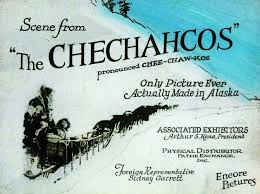 The Chechahcos (Dir. Lewis H. Moomaw, US, 1924) (87 mins) Set in the 1890s as the Klondike gold rush sucks in thousands of fortune huntes to the icy wastes of Alaska hoping to make it rich (one way or another), when a fire engulfs a shipload of prospectors Margaret Stanlaw (Eve Gorden) is separated from her young daughter Ruth in the confusion. Mrs Stanlaw is led to believe that her daughter is dead but instead the child ends up in the care of a couple of rough-edged prospectors. Years pass and the now adult Ruth (Gladys Johnson) is in love with one of her by-now prosperous guardians. But danger is afoot when an old adversary of the prospector arrives in town, along with Mrs. Stanlaw
The Chechahcos (Dir. Lewis H. Moomaw, US, 1924) (87 mins) Set in the 1890s as the Klondike gold rush sucks in thousands of fortune huntes to the icy wastes of Alaska hoping to make it rich (one way or another), when a fire engulfs a shipload of prospectors Margaret Stanlaw (Eve Gorden) is separated from her young daughter Ruth in the confusion. Mrs Stanlaw is led to believe that her daughter is dead but instead the child ends up in the care of a couple of rough-edged prospectors. Years pass and the now adult Ruth (Gladys Johnson) is in love with one of her by-now prosperous guardians. But danger is afoot when an old adversary of the prospector arrives in town, along with Mrs. Stanlaw  who remains unaware that her daughter has survived. I stumbled upon The Chechahcos ( a native Alaskan word meaning ‘tenderfoot‘) by accident, never having previously heard of the film but it turned out to be a pleasent discovery. The only film made by the Alaska Moving Pictures Corporation and the first film shot entirely on location in Alaska it features some stunning photography capturing both the
who remains unaware that her daughter has survived. I stumbled upon The Chechahcos ( a native Alaskan word meaning ‘tenderfoot‘) by accident, never having previously heard of the film but it turned out to be a pleasent discovery. The only film made by the Alaska Moving Pictures Corporation and the first film shot entirely on location in Alaska it features some stunning photography capturing both the  ruggedness of the country and the privations of the prospectors as they cross icy glacial passes or traverse river rapids in frail boats. And the story is not bad either. On completion the film was picked up by a major distributor, review screenings were positive and the film was set for a big fanfare release. But for inexplicable reasons the crowds stayed away. Perhaps it was the absence of big name stars amongst the cast, perhaps it was the unpronounceable title ( Chee-chaw-koz). But whatever the reason, the film had just a short run before it disappeared until, ninety odd years later it was rediscovered, restored by the University of Alaska and re-screened in Anchorage with a new orchestral score. Find out more at www.loc.gov. There is a good quality print on the National Film Preservation Foundation website here which comes with a nice piano accompaniment (although I did have great difficulty streaming this). A lower quality version is available here on You Tube but without musical accompaniment. If you want to buy the film on DVD it is available from the Anchorage Fine Arts Society here in a version featuring the newly commissioned orchestral score.
ruggedness of the country and the privations of the prospectors as they cross icy glacial passes or traverse river rapids in frail boats. And the story is not bad either. On completion the film was picked up by a major distributor, review screenings were positive and the film was set for a big fanfare release. But for inexplicable reasons the crowds stayed away. Perhaps it was the absence of big name stars amongst the cast, perhaps it was the unpronounceable title ( Chee-chaw-koz). But whatever the reason, the film had just a short run before it disappeared until, ninety odd years later it was rediscovered, restored by the University of Alaska and re-screened in Anchorage with a new orchestral score. Find out more at www.loc.gov. There is a good quality print on the National Film Preservation Foundation website here which comes with a nice piano accompaniment (although I did have great difficulty streaming this). A lower quality version is available here on You Tube but without musical accompaniment. If you want to buy the film on DVD it is available from the Anchorage Fine Arts Society here in a version featuring the newly commissioned orchestral score.
27 May
 Hindle Wakes (Dir. Maurice Elvey, UK, 1927) (115 mins) In the mill town of Hindle, ‘wakes week’ is the seven day shut-down when the workers head off for their annual seaside holiday. Amongst them is the exuberant shop floor worker Fanny Hawthorn (Estelle Brody) who meets with and has a brief affair with the mill owner’s son, Alan
Hindle Wakes (Dir. Maurice Elvey, UK, 1927) (115 mins) In the mill town of Hindle, ‘wakes week’ is the seven day shut-down when the workers head off for their annual seaside holiday. Amongst them is the exuberant shop floor worker Fanny Hawthorn (Estelle Brody) who meets with and has a brief affair with the mill owner’s son, Alan  Jeffcote. When the affair is discovered by their parents the pressure is on Allan to ‘do the decent thing’ and marry Fanny. But Fanny herself has other ideas…..There is the long held view that nothing much happened in the world of British silent film of the 1920s until the arrival of Alfred Hitchcock. Whilst such a reading of film history ignores the work of Hitchcock contemporary Anthony Asquith it also neglects the fact that Maurice Elvey had been turning out quality silents for over a decade by the time of Hindle Wakes. Based on the (at the time) scandalous 1912 stage play of the same name by Stanley Houghton, Hindle Wakes is probably Elvey’s finest work. The first half is a whirlwind of
Jeffcote. When the affair is discovered by their parents the pressure is on Allan to ‘do the decent thing’ and marry Fanny. But Fanny herself has other ideas…..There is the long held view that nothing much happened in the world of British silent film of the 1920s until the arrival of Alfred Hitchcock. Whilst such a reading of film history ignores the work of Hitchcock contemporary Anthony Asquith it also neglects the fact that Maurice Elvey had been turning out quality silents for over a decade by the time of Hindle Wakes. Based on the (at the time) scandalous 1912 stage play of the same name by Stanley Houghton, Hindle Wakes is probably Elvey’s finest work. The first half is a whirlwind of  stunning location shooting while the second half (where Houghton’s original play began) is intense and gripping melodrama. For its time the film (and presumably even more so the earlier stage play) is a remarkable expression of female emancipation. But subjects addressed by the film go further than this, focusing in particular on the issue of class and the
stunning location shooting while the second half (where Houghton’s original play began) is intense and gripping melodrama. For its time the film (and presumably even more so the earlier stage play) is a remarkable expression of female emancipation. But subjects addressed by the film go further than this, focusing in particular on the issue of class and the  moral and social codes of behavior faced primarily by the working classes and especially working class women, as well as the ever present theme of missed opportunity. Then there is the terrific ensemble cast performance although Estell Brody in particular shines out. All in all, Hindle Wakes stands out as a silent film the quality of which matches anything being produced in Europe or America at that time. Read our (with spoilers) review here or find out more at silentlondon.co.uk . The version avaible here on You Tube is a high quality print from the BFI’s National Film Archive. However, it comes without sound accompaniment. Hindle Wakes is available on (Region 1) DVD from Milestone Films here with two alternative original scores by In the Nursery and Philip Carli.
moral and social codes of behavior faced primarily by the working classes and especially working class women, as well as the ever present theme of missed opportunity. Then there is the terrific ensemble cast performance although Estell Brody in particular shines out. All in all, Hindle Wakes stands out as a silent film the quality of which matches anything being produced in Europe or America at that time. Read our (with spoilers) review here or find out more at silentlondon.co.uk . The version avaible here on You Tube is a high quality print from the BFI’s National Film Archive. However, it comes without sound accompaniment. Hindle Wakes is available on (Region 1) DVD from Milestone Films here with two alternative original scores by In the Nursery and Philip Carli.
18 May
 Underworld ( Dir.Josef von Sternberg, US, 1927) (80mins) Brash gang boss ‘Bull’ Weed (George Bancroft) saves ‘Rolls Royce’ Wensel (Clive Brook), previously a lawyer but now a
Underworld ( Dir.Josef von Sternberg, US, 1927) (80mins) Brash gang boss ‘Bull’ Weed (George Bancroft) saves ‘Rolls Royce’ Wensel (Clive Brook), previously a lawyer but now a  down and out alcoholic, from a rival gang boss. They team up together with Rolls Royce providing the intelligence for Weed’s criminal activities. However, when Rolls Royce begins to fall for Weed’s girl, ‘Feathers’ McCoy (Evelyn Brent), his jealousy knows no bounds and is likely to get everyone killed. Underworld is now recognised as one of the great gangster films of the silent era and, along with The Racket (see below) set most of the rules for the gangster movie genre for the next 60 years. George Bancroft may have been a bit ‘over the top’ as Weed but he set the tone for Paul Muni in Scarface (1932). Clive Brook and Evelyn Brent play off each other wonderfully and Evelyn
down and out alcoholic, from a rival gang boss. They team up together with Rolls Royce providing the intelligence for Weed’s criminal activities. However, when Rolls Royce begins to fall for Weed’s girl, ‘Feathers’ McCoy (Evelyn Brent), his jealousy knows no bounds and is likely to get everyone killed. Underworld is now recognised as one of the great gangster films of the silent era and, along with The Racket (see below) set most of the rules for the gangster movie genre for the next 60 years. George Bancroft may have been a bit ‘over the top’ as Weed but he set the tone for Paul Muni in Scarface (1932). Clive Brook and Evelyn Brent play off each other wonderfully and Evelyn  Brent herself is just, well, wonderful. Her eyebrows alone could act most anyone else off the screen. The film marked out von Sternberg as a truly great director and the film was a huge critical and popular success across the world. See our (with spoilers) review here or find out more at immortalephemera.com. The version here on You Tube comes with a good orchestral accompaniment. If you want to buy it on disc, a Criterion release here is a three film von Sternberg compilation along with the equally enjoyable The Docks Of New York and The Last Command
Brent herself is just, well, wonderful. Her eyebrows alone could act most anyone else off the screen. The film marked out von Sternberg as a truly great director and the film was a huge critical and popular success across the world. See our (with spoilers) review here or find out more at immortalephemera.com. The version here on You Tube comes with a good orchestral accompaniment. If you want to buy it on disc, a Criterion release here is a three film von Sternberg compilation along with the equally enjoyable The Docks Of New York and The Last Command
 The Racket (Dir. Lewis Milestone, US, 1928) (84 mins) James McQuigg (Thomas Meighan) and Nick Scarsi (Louis Walheim) are old friends who now sit on opposite sides of the law. McQuigg is that rare commodity in 1920s Chicago, an honest cop, while Scarsi runs runs one of the biggest criminal gangs in the city. Despite McQuigg’s attempts to take him down, Scarsi has the judges and politicians in his pocket. Eventually Scarsi tires of McQuigg’s efforts and gets him transferred to a backwater precinct. But
The Racket (Dir. Lewis Milestone, US, 1928) (84 mins) James McQuigg (Thomas Meighan) and Nick Scarsi (Louis Walheim) are old friends who now sit on opposite sides of the law. McQuigg is that rare commodity in 1920s Chicago, an honest cop, while Scarsi runs runs one of the biggest criminal gangs in the city. Despite McQuigg’s attempts to take him down, Scarsi has the judges and politicians in his pocket. Eventually Scarsi tires of McQuigg’s efforts and gets him transferred to a backwater precinct. But  McQuigg sees a chance to get back at Scarsi through his less than smart younger brother and a gold-digging nightclub singer (Marie Prevost). However, its a course of action which will come at a heavy cost for all involved. Long thought lost, a copy The Racket was discovered in Howard Hughes‘ personal archives after the reclusive billionaire’s death. Based on Bartlett Cormack’s 1927 play which was a huge hit starring Edward G. Robinson, a 22 year old Hughes brought the rights for one of his early forays into film making. Looking at the film now it can give an almost
McQuigg sees a chance to get back at Scarsi through his less than smart younger brother and a gold-digging nightclub singer (Marie Prevost). However, its a course of action which will come at a heavy cost for all involved. Long thought lost, a copy The Racket was discovered in Howard Hughes‘ personal archives after the reclusive billionaire’s death. Based on Bartlett Cormack’s 1927 play which was a huge hit starring Edward G. Robinson, a 22 year old Hughes brought the rights for one of his early forays into film making. Looking at the film now it can give an almost  overly cliched feel until you realise that this was in fact the film that first set in train many of the familiar tropes of the gangster film genre. Meighan is good as McQuigg but Walheim is awesome as the brutish Scarsi. However, Marie Prevost steals every scene she is in as the hard-bitten moll. Director Milestone created some incredible studio scenes of the hustle and bustle of Chicago streets but nothing beats the scene in the basement speakeasy as the two rival gangs plus the police cautiously eye each other up with almost balletic poise before the first shot rings out. Find out more at immortalephemera.com. There is a nicely restored version here on You Tube with a musical score composed by Robert Israel. The Racket has been available to buy on DVD via Flicker Alley but does not appear currently available.
overly cliched feel until you realise that this was in fact the film that first set in train many of the familiar tropes of the gangster film genre. Meighan is good as McQuigg but Walheim is awesome as the brutish Scarsi. However, Marie Prevost steals every scene she is in as the hard-bitten moll. Director Milestone created some incredible studio scenes of the hustle and bustle of Chicago streets but nothing beats the scene in the basement speakeasy as the two rival gangs plus the police cautiously eye each other up with almost balletic poise before the first shot rings out. Find out more at immortalephemera.com. There is a nicely restored version here on You Tube with a musical score composed by Robert Israel. The Racket has been available to buy on DVD via Flicker Alley but does not appear currently available.
17 May
 Paris Qui Dort (aka While Paris Sleeps, aka The Crazy Ray) (Dir. Rene Clair, Fr, 1924) (65mins) The night watchman on the Eiffel Tower wakes to find that all of the rest of Paris has been put to sleep, leaving him alone in the city with the buildings and streets eerily empty. Eventually he meets a disparate group of four men and a woman who have just arrived in the city by air. But with limitless time on their hands and nothing to do (not a dissimilar state than most of us find
Paris Qui Dort (aka While Paris Sleeps, aka The Crazy Ray) (Dir. Rene Clair, Fr, 1924) (65mins) The night watchman on the Eiffel Tower wakes to find that all of the rest of Paris has been put to sleep, leaving him alone in the city with the buildings and streets eerily empty. Eventually he meets a disparate group of four men and a woman who have just arrived in the city by air. But with limitless time on their hands and nothing to do (not a dissimilar state than most of us find  ourselves at the moment) boredom sets in not to mention romantic notions and jealousy. And we haven’t even got to the mad scientist bit yet!!. Paris Qui Dort was director Rene Clair’s first film (although his second, Entr’acte, was released before it) and it is a lovely comic fantasy. Shot on a shoe-string budget there is some amazing camerawork, not just of the empty streets of Paris but also as the group traverse the Eiffel Tower. The scene as the group socialise amongst the sleeping nightclub clientele has a slightly eerie quality but there are plenty of little comic asides, particularly from the gentleman thief of the group (not least when he has the Mona Lisa tucked away in the back of his car). The film is much less the pure
ourselves at the moment) boredom sets in not to mention romantic notions and jealousy. And we haven’t even got to the mad scientist bit yet!!. Paris Qui Dort was director Rene Clair’s first film (although his second, Entr’acte, was released before it) and it is a lovely comic fantasy. Shot on a shoe-string budget there is some amazing camerawork, not just of the empty streets of Paris but also as the group traverse the Eiffel Tower. The scene as the group socialise amongst the sleeping nightclub clientele has a slightly eerie quality but there are plenty of little comic asides, particularly from the gentleman thief of the group (not least when he has the Mona Lisa tucked away in the back of his car). The film is much less the pure  surrealistic experiment of Entr’acte, and more an exercise in fantasy colliding with reality. Find out more at ithankyouarthur.blogspot.com. The version here is a stunning restoration from Cinematheque Francaise, with a very nice piano accompaniment also. Sadly it is one of the few equally beautiful films in their On-Line collection that comes in English (somewhat bizarrely in this case because the inter-titles themselves are in English but have then been sub-titled into French). If you want a copy of Paris Qui Dort, its available on disc direct from Criterion as an extra to their release of Rene’s Sous Les Toits De Paris (1930) here or via Amazon here
surrealistic experiment of Entr’acte, and more an exercise in fantasy colliding with reality. Find out more at ithankyouarthur.blogspot.com. The version here is a stunning restoration from Cinematheque Francaise, with a very nice piano accompaniment also. Sadly it is one of the few equally beautiful films in their On-Line collection that comes in English (somewhat bizarrely in this case because the inter-titles themselves are in English but have then been sub-titled into French). If you want a copy of Paris Qui Dort, its available on disc direct from Criterion as an extra to their release of Rene’s Sous Les Toits De Paris (1930) here or via Amazon here
16 May
 The Great Road (Dir. Sun Yu, Chi, 1934) (104 mins) The film follows the lives of a group of six itinerant road construction workers led by Brother Jin (Jin Yan) together with two girls they meet in the course of their travels, Jasmine ( Li Li-Li) and Ding Xiang (Chen Yen-yen). With the Japanese invading, construction of the road takes on strategic importance but their is treachery afoot. In some
The Great Road (Dir. Sun Yu, Chi, 1934) (104 mins) The film follows the lives of a group of six itinerant road construction workers led by Brother Jin (Jin Yan) together with two girls they meet in the course of their travels, Jasmine ( Li Li-Li) and Ding Xiang (Chen Yen-yen). With the Japanese invading, construction of the road takes on strategic importance but their is treachery afoot. In some  ways an obvious propaganda film extolling the virtue of collective patriotic effort to defeat a common enemy, the film nevertheless has considerable charm with comedic and romantic interludes. One scene in particular is very funny but also an unusual reversal of normal sexual stereotypes, when the two girls come across the work gang bathing naked in the river. Here it is the men who are embarrassed while it is Jasmine doing the ogling. This was another film in
ways an obvious propaganda film extolling the virtue of collective patriotic effort to defeat a common enemy, the film nevertheless has considerable charm with comedic and romantic interludes. One scene in particular is very funny but also an unusual reversal of normal sexual stereotypes, when the two girls come across the work gang bathing naked in the river. Here it is the men who are embarrassed while it is Jasmine doing the ogling. This was another film in  which Li Li-Li excelled, made the same year as Queen Of Sports (see 27 April, below) and cementing her position as one of the most popular actors of her day. The Great Road came at the tail end of China’s silent film era and is a kind of silent/talkie hybrid, still reliant on inter-titles but also with a partial recorded soundtrack of syncronised songs and sound effects. Find out more at wikipedia.org. The version here on You Tube comes with the benefit of English translations of the inter-titles and songs but is of poor quality both in sound and vision. However, there does not appear to be a better version of the film from any source and it is one that cries out for a decent restoration. A version of unknown quality was released on disc by CinemaEpoch but no longer seems to be available.
which Li Li-Li excelled, made the same year as Queen Of Sports (see 27 April, below) and cementing her position as one of the most popular actors of her day. The Great Road came at the tail end of China’s silent film era and is a kind of silent/talkie hybrid, still reliant on inter-titles but also with a partial recorded soundtrack of syncronised songs and sound effects. Find out more at wikipedia.org. The version here on You Tube comes with the benefit of English translations of the inter-titles and songs but is of poor quality both in sound and vision. However, there does not appear to be a better version of the film from any source and it is one that cries out for a decent restoration. A version of unknown quality was released on disc by CinemaEpoch but no longer seems to be available.
 Helen Of Four Gates (Dir. Cecil Hepworth, UK, 1920) (77 mins) When Helen (Alma Taylor) forsakes suitor Abel Mason (James Carew) in order to marry another, little does she know that she has set in train a lasting hatred. Two years later, Helen’s husband is dead and she, at death’s door herself, entrusts the care of her new born baby (also called Helen) to Mason. But Mason only accepts care of the baby in order to make its life as miserable as possible in
Helen Of Four Gates (Dir. Cecil Hepworth, UK, 1920) (77 mins) When Helen (Alma Taylor) forsakes suitor Abel Mason (James Carew) in order to marry another, little does she know that she has set in train a lasting hatred. Two years later, Helen’s husband is dead and she, at death’s door herself, entrusts the care of her new born baby (also called Helen) to Mason. But Mason only accepts care of the baby in order to make its life as miserable as possible in  revenge for Helen rejecting him. Twenty years pass and the now grown Helen (Alma Taylor) is the drudge of the farm, mercilessly ill-treated by Mason. When Helen strikes up a friendship with farm worker Martin Scott (George Dewhurst) she sees a chance of happiness but will Mason stand by and let it happen? Based upon a novel by former mill girl Ethel Carnie Holdsworth, Hepworth’s film was long thought lost until a copy was
revenge for Helen rejecting him. Twenty years pass and the now grown Helen (Alma Taylor) is the drudge of the farm, mercilessly ill-treated by Mason. When Helen strikes up a friendship with farm worker Martin Scott (George Dewhurst) she sees a chance of happiness but will Mason stand by and let it happen? Based upon a novel by former mill girl Ethel Carnie Holdsworth, Hepworth’s film was long thought lost until a copy was  discovered in 2007 in a Montreal film archive. The film has a curiously dated style, with often overly extended scenes and sometimes overtly theatrical acting, well behind the technical sophistication of film production in Europe or America at that time. But despite this the location shooting has a ravishing beauty, filmed on the wild moors above Hebden Bridge in Yorkshire, where the original novel was set. The film also affords the chance to see one of Hepworth’s few surviving films. When his studios went bankrupt creditors tragically melted down all his original negatives and prints to retrieve the film’s silver content. Find out more at screenonline.org.uk The version here comes via the BFI Player. Unfortunately it does not have musical accompaniment. The film does not appear to be available to purchase from any source.
discovered in 2007 in a Montreal film archive. The film has a curiously dated style, with often overly extended scenes and sometimes overtly theatrical acting, well behind the technical sophistication of film production in Europe or America at that time. But despite this the location shooting has a ravishing beauty, filmed on the wild moors above Hebden Bridge in Yorkshire, where the original novel was set. The film also affords the chance to see one of Hepworth’s few surviving films. When his studios went bankrupt creditors tragically melted down all his original negatives and prints to retrieve the film’s silver content. Find out more at screenonline.org.uk The version here comes via the BFI Player. Unfortunately it does not have musical accompaniment. The film does not appear to be available to purchase from any source.
13 May
 Orchids And Ermine (Dir. Alfred Santell, US, 1927) (66 mins) Pink Watson (Colleen Moore) works as a telephone operator at a cement factory but she
Orchids And Ermine (Dir. Alfred Santell, US, 1927) (66 mins) Pink Watson (Colleen Moore) works as a telephone operator at a cement factory but she  has dreams of making it big, So when the chance of a job in a swanky hotel comes along she leaps at it, anticipating finding a rich husband and living the life or orchids and ermine. When hotel florist Ermintrude De Vere (Gwen Lee) introduces Pink to an oil millionaire and his loyal valet (Jack Mulhall and Sam Hardy) she thinks her luck is in, but which one is the millionaire and which the valet? Orchids and Ermine is by far my favourite Colleen Moore film, a charming and gentle comedy and the perfect vehicle for her comedic talent and sparkling personality. Jack Mulhall is good as the male lead but is somewhat out-shone by the worldly wise
has dreams of making it big, So when the chance of a job in a swanky hotel comes along she leaps at it, anticipating finding a rich husband and living the life or orchids and ermine. When hotel florist Ermintrude De Vere (Gwen Lee) introduces Pink to an oil millionaire and his loyal valet (Jack Mulhall and Sam Hardy) she thinks her luck is in, but which one is the millionaire and which the valet? Orchids and Ermine is by far my favourite Colleen Moore film, a charming and gentle comedy and the perfect vehicle for her comedic talent and sparkling personality. Jack Mulhall is good as the male lead but is somewhat out-shone by the worldly wise  (or so he thinks) Sam Hardy. Look out for
(or so he thinks) Sam Hardy. Look out for  a brief appearance by a diminutive Mickey Rooney in an early role. There is also some nice location shooting on the rain-swept streets of New York. An all-round feel-good film if ever there was one. Find out more at ithankyouarthur.blogspot.com. The version here on You Tube isn’t of brilliant quality but does come with musical accompaniment (albeit a bit scratchy!). In fact, you’ll be hard pressed to purchase a better quality version on disc. Until recently grapevine video stocked a similar quality version but even that now seems to have been deleted.
a brief appearance by a diminutive Mickey Rooney in an early role. There is also some nice location shooting on the rain-swept streets of New York. An all-round feel-good film if ever there was one. Find out more at ithankyouarthur.blogspot.com. The version here on You Tube isn’t of brilliant quality but does come with musical accompaniment (albeit a bit scratchy!). In fact, you’ll be hard pressed to purchase a better quality version on disc. Until recently grapevine video stocked a similar quality version but even that now seems to have been deleted.
 It (Dir. Clarence G Badger, US, 1927) (72 mins) Betty Lou Spence (Clara Bow) may be just a humble shop floor worker, but she’s certainly got ‘It’. And when she sets her mind
It (Dir. Clarence G Badger, US, 1927) (72 mins) Betty Lou Spence (Clara Bow) may be just a humble shop floor worker, but she’s certainly got ‘It’. And when she sets her mind  on capturing the heart of the boss nothing is going to stand in her way. But things go astray when Betty, trying to protect her friend, claims that her friend’s baby is in fact hers. It is one of the seminal films of the flapper era. Its writer, Elinor Glyn, even has a role in the film where she sets out exactly what having ‘It’ really means. The plot may be painfully thin and inconsequential but it doesn’t matter because Clara Bow is at her best here, well on her way to being the biggest movie star of the late 1920s and the very definition of the ‘It Girl’. The male lead was Spanish born Antonio Moreno, a film veteran from the mid-teens and often cast as the ‘Latin Lover’ long before Valentino made the role his own. Hampered by his strong accent with the arrival of the talkies
on capturing the heart of the boss nothing is going to stand in her way. But things go astray when Betty, trying to protect her friend, claims that her friend’s baby is in fact hers. It is one of the seminal films of the flapper era. Its writer, Elinor Glyn, even has a role in the film where she sets out exactly what having ‘It’ really means. The plot may be painfully thin and inconsequential but it doesn’t matter because Clara Bow is at her best here, well on her way to being the biggest movie star of the late 1920s and the very definition of the ‘It Girl’. The male lead was Spanish born Antonio Moreno, a film veteran from the mid-teens and often cast as the ‘Latin Lover’ long before Valentino made the role his own. Hampered by his strong accent with the arrival of the talkies  he made the switch to starring in some well received Mexican productions before returning to Hollywood in later years to appear in productions such as Creature From The Black Lagoon (1954) and The Searchers (1955). Find out more at www.loc.gov. The version here is the sadly long-out-of-print Milestone release with a knock-out score from Carl Davis. But if you want to buy a copy with alternative musical accompaniment you can do so here
he made the switch to starring in some well received Mexican productions before returning to Hollywood in later years to appear in productions such as Creature From The Black Lagoon (1954) and The Searchers (1955). Find out more at www.loc.gov. The version here is the sadly long-out-of-print Milestone release with a knock-out score from Carl Davis. But if you want to buy a copy with alternative musical accompaniment you can do so here
12 May
 The Flapper (Dir. Alan Crosland, US, 1920) (88 mins) High-spirited 16 year old Genevieve ‘Ginger’ King (Olive Thomas) is packed off to boarding school by her wealthy father when she becomes too much for sedate Orange Springs. And that’s where the fun starts She falls for an older man, gets involved with some jewel thieves and innocently ends up carrying the loot. But when she attempts to use the stolen jewels to pass herself off as the sophisticated ‘flapper’ of the title, that’s when her troubles begin. The Flapper was scripted by Francis
The Flapper (Dir. Alan Crosland, US, 1920) (88 mins) High-spirited 16 year old Genevieve ‘Ginger’ King (Olive Thomas) is packed off to boarding school by her wealthy father when she becomes too much for sedate Orange Springs. And that’s where the fun starts She falls for an older man, gets involved with some jewel thieves and innocently ends up carrying the loot. But when she attempts to use the stolen jewels to pass herself off as the sophisticated ‘flapper’ of the title, that’s when her troubles begin. The Flapper was scripted by Francis  Marion and is credited with popularizing the slang term “flapper” throughout the United States in the 1920s, although the flapper of this film was somewhat tame by comparison with Hollywood depictions by the mid-1920s. However, the film remains an amusing if somewhat thinly plotted comedy. Star Olive Thomas was in her mid-twenties when she made the film but managed a credible portrayal of teenager Ginger. After winning a “Most Beautiful Girl in New York City” contest in 1914 Thomas became an
Marion and is credited with popularizing the slang term “flapper” throughout the United States in the 1920s, although the flapper of this film was somewhat tame by comparison with Hollywood depictions by the mid-1920s. However, the film remains an amusing if somewhat thinly plotted comedy. Star Olive Thomas was in her mid-twenties when she made the film but managed a credible portrayal of teenager Ginger. After winning a “Most Beautiful Girl in New York City” contest in 1914 Thomas became an  artist’s model and then a Ziegfeld Girl before moving into pictures. Married to Jack Pickford, Mary’s younger brother, the two had a turbulent relationship and just months after the completion of The Flapper while the couple were visiting Paris. she drank poison in still unclear circumstances and died shortly afterwards. Oh, and look out for Norma Shearer in an early un-credited role as one of Ginger’s school girl friends. Find out more at imdb.com . The version here comes courtesy of Silent Hall Of Fame, although it lacks musical accompaniment. . There are other versions on You Tube but they are let down by dismal ‘music’. The Flapper is available on DVD from Milestone Films here
artist’s model and then a Ziegfeld Girl before moving into pictures. Married to Jack Pickford, Mary’s younger brother, the two had a turbulent relationship and just months after the completion of The Flapper while the couple were visiting Paris. she drank poison in still unclear circumstances and died shortly afterwards. Oh, and look out for Norma Shearer in an early un-credited role as one of Ginger’s school girl friends. Find out more at imdb.com . The version here comes courtesy of Silent Hall Of Fame, although it lacks musical accompaniment. . There are other versions on You Tube but they are let down by dismal ‘music’. The Flapper is available on DVD from Milestone Films here
10 May
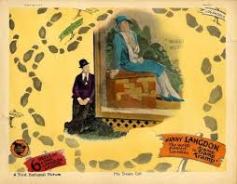 Tramp, Tramp, Tramp (Dir. Harry Edwards, US, 1926) (62 mins) With the mighty Burton Shoe Corp. driving all the opposition out of business Harry Logan (Harry Langdon) needs to raise money quickly to save his shoe-maker father from being evicted. But Harry is distracted by his infatuation for the girl in the Burton’s advertising poster. Yet, by a twist of fate he is entered in
Tramp, Tramp, Tramp (Dir. Harry Edwards, US, 1926) (62 mins) With the mighty Burton Shoe Corp. driving all the opposition out of business Harry Logan (Harry Langdon) needs to raise money quickly to save his shoe-maker father from being evicted. But Harry is distracted by his infatuation for the girl in the Burton’s advertising poster. Yet, by a twist of fate he is entered in  Burton’s marketing ploy, a transcontinental walking race with a $25,000 first prize. Tramp, Tramp, Tramp was Harry Langdon’s first feature length comedy and, although I’m still not sure I’d include him with the other big three of silent comedy (Keaton, Lloyd and Chaplin), its a pretty good effort. Langdon’s bumbling, simpleton, man-child persona can become tiring at times but there are some funny set-piece scenes and Joan Crawford adds some glamour in one of her first starring roles. Find out more at ithankyouarthur.blogspot.com. The version of the film here via Daily Motion is of very good quality with a nice piano accompaniment.
Burton’s marketing ploy, a transcontinental walking race with a $25,000 first prize. Tramp, Tramp, Tramp was Harry Langdon’s first feature length comedy and, although I’m still not sure I’d include him with the other big three of silent comedy (Keaton, Lloyd and Chaplin), its a pretty good effort. Langdon’s bumbling, simpleton, man-child persona can become tiring at times but there are some funny set-piece scenes and Joan Crawford adds some glamour in one of her first starring roles. Find out more at ithankyouarthur.blogspot.com. The version of the film here via Daily Motion is of very good quality with a nice piano accompaniment.
 Hamlet (Dir. Svend Gade/Heinz Schall, Ger, 1921) (116mins) A unique take on the bard’s great story, this version of Hamlet revolves around the premise of its namesake being born a girl but having been brought up disguised as a boy in order to maintain the pretense of a male heir to the throne. The production was a pet project of Danish star
Hamlet (Dir. Svend Gade/Heinz Schall, Ger, 1921) (116mins) A unique take on the bard’s great story, this version of Hamlet revolves around the premise of its namesake being born a girl but having been brought up disguised as a boy in order to maintain the pretense of a male heir to the throne. The production was a pet project of Danish star  Asta Nielsen, the first diva of European silent film, who founded her own production company to bring the project to fruition and probably had a considerable influence in the direction of the film. Her memorable performance in the leading role stands out for its subtle, under-stated and naturalistic style The film also reflects the scale, sophistication and capability of German film production of the time. There are no wobbly cardboard sets here and no expense has been spared on the large cast of extras, costuming and crowd scenes. Read our (with spoilers) review here. Find out more at silentsplease.wordpress.com The version here on You Tube is a beautifully tinted restoration with a wonderfully evocative musical accompaniment by Michael Riessler.
Asta Nielsen, the first diva of European silent film, who founded her own production company to bring the project to fruition and probably had a considerable influence in the direction of the film. Her memorable performance in the leading role stands out for its subtle, under-stated and naturalistic style The film also reflects the scale, sophistication and capability of German film production of the time. There are no wobbly cardboard sets here and no expense has been spared on the large cast of extras, costuming and crowd scenes. Read our (with spoilers) review here. Find out more at silentsplease.wordpress.com The version here on You Tube is a beautifully tinted restoration with a wonderfully evocative musical accompaniment by Michael Riessler.
 Last of the Mohicans (Dir. Maurice Tourneur/Clarence Brown, US, 1920) (71mins) Last Of The Mohicans tells the story of two English sisters (Barbara Bedford and Lillian Hall) meeting danger on the frontier of the American colonies, in and around the fort commanded by their father, the sisters’ only hope of survival against the French forces
Last of the Mohicans (Dir. Maurice Tourneur/Clarence Brown, US, 1920) (71mins) Last Of The Mohicans tells the story of two English sisters (Barbara Bedford and Lillian Hall) meeting danger on the frontier of the American colonies, in and around the fort commanded by their father, the sisters’ only hope of survival against the French forces 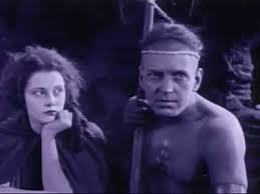 and a menacing Huron Indian called Magua is with the son of the last chief of the Mohican tribe, the hunky yet majestic Uncas (Albert Roscoe). Based on James Fenimore Cooper’s 1826 best-selling novel and set during the French and Indian War, when France and Great Britain battled for control of North America, what ensues is an epic battle of survival, betrayal, murder and love nearly all of which is shot on location amongst some of the most incredible forests and mountainous landscapes ever put on film. Barbara Bedford is excellent as Cora. Although she had a long career in both silents and talkies, she never seemed to achieve the stardom that this early performance promised. Wallace Beery is suitably menacing as the evil Magua and there is supposed to be an un-credited role for Boris Karloff as an Indian but I’ve never been able to spot him. Find out more at latimesblogs.latimes.com. The version here on publicdomainreview.org is of reasonable quality (although look out for a beautifully tinted version if you can find it). This version is accompanied by a compendium of classical music extracts, some of which work better than others.
and a menacing Huron Indian called Magua is with the son of the last chief of the Mohican tribe, the hunky yet majestic Uncas (Albert Roscoe). Based on James Fenimore Cooper’s 1826 best-selling novel and set during the French and Indian War, when France and Great Britain battled for control of North America, what ensues is an epic battle of survival, betrayal, murder and love nearly all of which is shot on location amongst some of the most incredible forests and mountainous landscapes ever put on film. Barbara Bedford is excellent as Cora. Although she had a long career in both silents and talkies, she never seemed to achieve the stardom that this early performance promised. Wallace Beery is suitably menacing as the evil Magua and there is supposed to be an un-credited role for Boris Karloff as an Indian but I’ve never been able to spot him. Find out more at latimesblogs.latimes.com. The version here on publicdomainreview.org is of reasonable quality (although look out for a beautifully tinted version if you can find it). This version is accompanied by a compendium of classical music extracts, some of which work better than others.
9 May
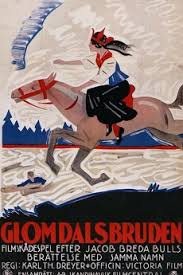 The Bride of Glomdal (aka Glomdalsbruden) (Dir. Carl Theodor Dreyer. Nor., 1926). (115 mins) Returning home after many years away, Tore Braaten (Einar Sissener) takes over the rundown family farm intending to make it into a big successful enterprise like
The Bride of Glomdal (aka Glomdalsbruden) (Dir. Carl Theodor Dreyer. Nor., 1926). (115 mins) Returning home after many years away, Tore Braaten (Einar Sissener) takes over the rundown family farm intending to make it into a big successful enterprise like  Glomgården on the other side of the river, where beautiful Berit (Tove Tellback) lives. Tore falls in love with her, but her father has promised her to the rich Gjermund. As her wedding to Gjermund draws near, Berit runs away and seeks refuge with Tore and his parents. But will her father ever agree to her marriage to Tore. The Bride of Glomdal was but a stopgap project for director C T Dreyer prior to his departure to France to shoot The Passion of Joan of Arc. To accommodate the theatre schedules of his actors, and to
Glomgården on the other side of the river, where beautiful Berit (Tove Tellback) lives. Tore falls in love with her, but her father has promised her to the rich Gjermund. As her wedding to Gjermund draws near, Berit runs away and seeks refuge with Tore and his parents. But will her father ever agree to her marriage to Tore. The Bride of Glomdal was but a stopgap project for director C T Dreyer prior to his departure to France to shoot The Passion of Joan of Arc. To accommodate the theatre schedules of his actors, and to  embellish what he believed to be the relatively slender plot threads of the original novel written by Jacob Breda Bull, Dreyer uncharacteristically shot more or less off-the-cuff, albeit with a prepared list of scenes, throughout the summer of 1925. But the end result is in no way any sort of second rate production. The story is beautifully told, the acting excellent and the location shooting, particularly the river rapids finale, fantastic. Find out more at letterboxd.com. The version here on You Tube has a simple but beautiful piano accompaniment.
embellish what he believed to be the relatively slender plot threads of the original novel written by Jacob Breda Bull, Dreyer uncharacteristically shot more or less off-the-cuff, albeit with a prepared list of scenes, throughout the summer of 1925. But the end result is in no way any sort of second rate production. The story is beautifully told, the acting excellent and the location shooting, particularly the river rapids finale, fantastic. Find out more at letterboxd.com. The version here on You Tube has a simple but beautiful piano accompaniment.
 The Parson’s Widow (aka Prästänkan) (Dir. Carl Theodor Dreyer, Swe, 1920) (71mins) In 17th century Norway a young theology student determines to secure the position of parson so that he can have the means to marry his sweetheart. But his jubilation at triumphing over his rivals for the role is short-lived when he learns that the
The Parson’s Widow (aka Prästänkan) (Dir. Carl Theodor Dreyer, Swe, 1920) (71mins) In 17th century Norway a young theology student determines to secure the position of parson so that he can have the means to marry his sweetheart. But his jubilation at triumphing over his rivals for the role is short-lived when he learns that the 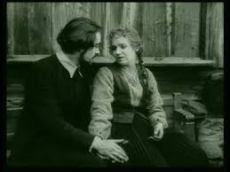 position is conditional upon marrying his predecessor’s widow. If all you know of the work of director C T Dreyer is the sombre genius of The Passion of Joan of Arc (1928) then you are in for a surprise here because The Parson’s Widow is a delightful comedy drama, albeit one that will break your heart at its finale. There are some wonderful laugh out loud moments, particularly the mistaken identity through the weaving loom or the parson’s costume intended to scare Dame Margarete out of the house. Einar Röd is excellent as the novice parson as is Greta Almroth as Mari, his intended. But the standout performance is that of Hildur Carlberg, who plays
position is conditional upon marrying his predecessor’s widow. If all you know of the work of director C T Dreyer is the sombre genius of The Passion of Joan of Arc (1928) then you are in for a surprise here because The Parson’s Widow is a delightful comedy drama, albeit one that will break your heart at its finale. There are some wonderful laugh out loud moments, particularly the mistaken identity through the weaving loom or the parson’s costume intended to scare Dame Margarete out of the house. Einar Röd is excellent as the novice parson as is Greta Almroth as Mari, his intended. But the standout performance is that of Hildur Carlberg, who plays  Dame Margarete, the aged widow of the dead parson. Sadly she herself died shortly after completion of filming, before the finished film was released. There is also an amazing cast of mostly amateur extras representing the somewhat grotesque village community. The film is beautifully shot on location at an open air museum in Lillehammer, Norway, with a ready-made set of stave church, parsonage, scattered farms, houses and buildings with furnishings and folk art all dating from the 17th century. The Parson’s Widow is an effortlessly charming yet deeply moving film. Find out more at silentlondon.co.uk The version here on You Tube isn’t the best quality restoration but it does benefit from a beautifully appropriate piano accompaniment which helps draw you in emotionally to the films narrative.
Dame Margarete, the aged widow of the dead parson. Sadly she herself died shortly after completion of filming, before the finished film was released. There is also an amazing cast of mostly amateur extras representing the somewhat grotesque village community. The film is beautifully shot on location at an open air museum in Lillehammer, Norway, with a ready-made set of stave church, parsonage, scattered farms, houses and buildings with furnishings and folk art all dating from the 17th century. The Parson’s Widow is an effortlessly charming yet deeply moving film. Find out more at silentlondon.co.uk The version here on You Tube isn’t the best quality restoration but it does benefit from a beautifully appropriate piano accompaniment which helps draw you in emotionally to the films narrative.
7 May
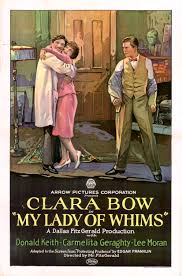 My Lady Of Whims (Dir. Dallas M Fitzgerald, US, 1925) (60 mins) When Prudence Severn (Clara Bow), the daughter of a rich family gets artistic inclinations and moves into a seedy Greenwich Village studio, two unemployed dough-boys (Donald Keith and Lee Moran) are hired to bring her to her senses and return her home. But Prudence proves a lot harder to handle than the boys anticipate. My Lady Of Whims was the last of 15 films Clara Bow made in 1925. Its an amusing comedy rather than a classic although it does have some funny moments. And any
My Lady Of Whims (Dir. Dallas M Fitzgerald, US, 1925) (60 mins) When Prudence Severn (Clara Bow), the daughter of a rich family gets artistic inclinations and moves into a seedy Greenwich Village studio, two unemployed dough-boys (Donald Keith and Lee Moran) are hired to bring her to her senses and return her home. But Prudence proves a lot harder to handle than the boys anticipate. My Lady Of Whims was the last of 15 films Clara Bow made in 1925. Its an amusing comedy rather than a classic although it does have some funny moments. And any 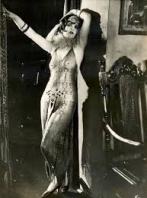 film featuring Clara Bow has to be worth watching, especially in ‘that’ dress! The film also marked the end of the film’s production company, Preferred Studios, although the studio head B P Schulberg apparently walked straight into a job at Paramount
film featuring Clara Bow has to be worth watching, especially in ‘that’ dress! The film also marked the end of the film’s production company, Preferred Studios, although the studio head B P Schulberg apparently walked straight into a job at Paramount  largely on the basis of bringing Ms Bow with him as he had her under a personal contract. Find out more at screeningthepast.com. The version here via You Tube isn’t of the best quality but it is about the most complete version I could find. Originally released at 70 mins, this version runs for 60 but others have been cut down to barely 35 minutes. It also comes with a somewhat scratchy but wholly appropriate jazz score.
largely on the basis of bringing Ms Bow with him as he had her under a personal contract. Find out more at screeningthepast.com. The version here via You Tube isn’t of the best quality but it is about the most complete version I could find. Originally released at 70 mins, this version runs for 60 but others have been cut down to barely 35 minutes. It also comes with a somewhat scratchy but wholly appropriate jazz score.
The White Hell Of Pitz Palu (Dir. Arnold Fanck/G W Pabst) (134 mins) The ‘alpine film’ is a curious and uniquely German film genre, sometimes seen in cultural and national identity terms as comparable to the American western. Although probably  less well than other films of the genre such as Struggle For The Matterhorn (1928) or Mountain of Destiny (1926), The White Hell of Pitz Palu is a good example of the style and content of the genre. The film opens with the wife of climber Johannes Kraff (Gustav Diesel) being swept to her death by an avalanche. In the years that follow he relentlessly searches for her body, earning the nickname ‘the ghost of the mountain’. Newly engaged couple Maria (Leni Riefenstahl) and Hans (Ernst Petersen) arrive at an alpine lodge at the foot of the mountain and meet Kraff. The three decide to climb the unconquered north face of Pitz Palu but as they ascend the tensions and the passions mount. Director Fanck was pretty much the instigator of the alpine drama genre and from him comes stunning footage of the mountain scenery in
less well than other films of the genre such as Struggle For The Matterhorn (1928) or Mountain of Destiny (1926), The White Hell of Pitz Palu is a good example of the style and content of the genre. The film opens with the wife of climber Johannes Kraff (Gustav Diesel) being swept to her death by an avalanche. In the years that follow he relentlessly searches for her body, earning the nickname ‘the ghost of the mountain’. Newly engaged couple Maria (Leni Riefenstahl) and Hans (Ernst Petersen) arrive at an alpine lodge at the foot of the mountain and meet Kraff. The three decide to climb the unconquered north face of Pitz Palu but as they ascend the tensions and the passions mount. Director Fanck was pretty much the instigator of the alpine drama genre and from him comes stunning footage of the mountain scenery in  both its beauty and power. But we probably have co-director Pabst to thank for the human drama. Riefenstahl had already starred in two of Fanck’s alpine dramas and would make two more after The White Hell of Pitz Palu before she moved on to directing first a melodrama and then her more renowned propaganda films. Indeed, the night time search for the lost climbers in this film, illuminated by blazing torches, is weirdly prescient of the night time Nazi rally scenes in Triumph of the Will. Find out more at silentsaregolden.com. The version here comes courtesy of Daily Motion and has an orchestral accompaniment to match the visual majesty and drama of the film.
both its beauty and power. But we probably have co-director Pabst to thank for the human drama. Riefenstahl had already starred in two of Fanck’s alpine dramas and would make two more after The White Hell of Pitz Palu before she moved on to directing first a melodrama and then her more renowned propaganda films. Indeed, the night time search for the lost climbers in this film, illuminated by blazing torches, is weirdly prescient of the night time Nazi rally scenes in Triumph of the Will. Find out more at silentsaregolden.com. The version here comes courtesy of Daily Motion and has an orchestral accompaniment to match the visual majesty and drama of the film.
 The House On Trubnaya (Dir. Boris Barnett, USSR, 1928) (84 mins) Country girl Paranya (Vera Maretskaya) arrives in Moscow, along with her pet duck, to stay with her uncle. But unbeknownst to Paranya he has returned to their village. Instead, she ends up staying with an old friend at the house on Trubnaya street where she meets hairdresser Mr Golikov (Vladimir Fogel) who
The House On Trubnaya (Dir. Boris Barnett, USSR, 1928) (84 mins) Country girl Paranya (Vera Maretskaya) arrives in Moscow, along with her pet duck, to stay with her uncle. But unbeknownst to Paranya he has returned to their village. Instead, she ends up staying with an old friend at the house on Trubnaya street where she meets hairdresser Mr Golikov (Vladimir Fogel) who  is looking for non-union labour to do his chores. But Mr Golikov’s hopes of an easy life with some cheap labour are thwarted when Paranya becomes a member of the Worker’s Council. There was a lot more to Soviet cinema of the 1920s than just political spectacle (Battleship Potemkin), montage (Man With A Movie Camera) or propaganda (Turksib). For one thing, there was comedy,
is looking for non-union labour to do his chores. But Mr Golikov’s hopes of an easy life with some cheap labour are thwarted when Paranya becomes a member of the Worker’s Council. There was a lot more to Soviet cinema of the 1920s than just political spectacle (Battleship Potemkin), montage (Man With A Movie Camera) or propaganda (Turksib). For one thing, there was comedy,  quite a lot of it in fact and much of it very good. A choice example is The House On Trubnaya which, as well as being very funny, is a dazzlingly well shot and superbly edited film, giving it a real sense of style and movement. The characters are well drawn, the actors (particularly Vera Maretskaya) are excellent and the film even gets over a serious political message. Find out more at sensesofcinema.com. The version here on You Tube comes with a pleasant accompaniment which matches the often frenetic pace of the film. In fact the film may just be a little too frenetic in this version, which runs for just 62 minutes but it seems to reflect simply an over-fast projection speed rather than an edited version.
quite a lot of it in fact and much of it very good. A choice example is The House On Trubnaya which, as well as being very funny, is a dazzlingly well shot and superbly edited film, giving it a real sense of style and movement. The characters are well drawn, the actors (particularly Vera Maretskaya) are excellent and the film even gets over a serious political message. Find out more at sensesofcinema.com. The version here on You Tube comes with a pleasant accompaniment which matches the often frenetic pace of the film. In fact the film may just be a little too frenetic in this version, which runs for just 62 minutes but it seems to reflect simply an over-fast projection speed rather than an edited version.
6 May
 Le Brasier Ardent (aka The Burning Crucible) (Dir. Ivan Mosjoukine, Fr, 1923) ( 107 mins) A woman, Elle (Nathalie Lissenko) suffers from vivid nightmares which feature an
Le Brasier Ardent (aka The Burning Crucible) (Dir. Ivan Mosjoukine, Fr, 1923) ( 107 mins) A woman, Elle (Nathalie Lissenko) suffers from vivid nightmares which feature an  unknown man’s face. Later, when her husband announces plans for them to leave her beloved Paris, Elle runs away. The husband attempts to follow but instead finds himself in the somewhat bizarre ‘Investigations Agency’. He arranges for them to track down his wife but the agent put on the case, Detective Z (Ivan Mosjoukine), is the very same man who has been appearing in his wife’s nightmares. Are you following so far? If you only know of Mosjoukine from his historical adventure film roles such as Michel Strogoff (1926) or The Loves of Casanova (1927) then nothing really prepares you for Le Brasier
unknown man’s face. Later, when her husband announces plans for them to leave her beloved Paris, Elle runs away. The husband attempts to follow but instead finds himself in the somewhat bizarre ‘Investigations Agency’. He arranges for them to track down his wife but the agent put on the case, Detective Z (Ivan Mosjoukine), is the very same man who has been appearing in his wife’s nightmares. Are you following so far? If you only know of Mosjoukine from his historical adventure film roles such as Michel Strogoff (1926) or The Loves of Casanova (1927) then nothing really prepares you for Le Brasier  Ardent, the only film which he wrote and directed as well as starred in. The opening dream sequence is like something out of Dante’s Inferno, the Investigations Agency is a masterpiece of surrealism, there is a 1920s dance marathon and a grand-mother fixated detective. The film is a visual masterpiece with striking sets and clever visual effects. Mosjoukine and his real life partner Lissenko play off each other beautifully and there are some wonderful location shots of Paris. Find out more at ithankyouarthur.blogspot.com. The version screened here on You Tube is Cinematheque Francais‘ beautifully restored and tinted version with nice piano accompaniment from Neil Brand although the English auto-translate of the French inter-titles sometimes left a bit to be desired.
Ardent, the only film which he wrote and directed as well as starred in. The opening dream sequence is like something out of Dante’s Inferno, the Investigations Agency is a masterpiece of surrealism, there is a 1920s dance marathon and a grand-mother fixated detective. The film is a visual masterpiece with striking sets and clever visual effects. Mosjoukine and his real life partner Lissenko play off each other beautifully and there are some wonderful location shots of Paris. Find out more at ithankyouarthur.blogspot.com. The version screened here on You Tube is Cinematheque Francais‘ beautifully restored and tinted version with nice piano accompaniment from Neil Brand although the English auto-translate of the French inter-titles sometimes left a bit to be desired.
5 May
 Soft Shoes (Dir. Lloyd Ingraham, US, 1925) (46 mins) Soft Shoes is a nice amalgam of western, crime melodrama and rom-com, with all of that being
Soft Shoes (Dir. Lloyd Ingraham, US, 1925) (46 mins) Soft Shoes is a nice amalgam of western, crime melodrama and rom-com, with all of that being  squeezed into just 46 minutes. Harry Carey is the rugged cowboy who comes to the big city to collect an inheritance. But his troubles are only just starting when he catches cat-burglar Faith O’Day (Lillian Rich) breaking in to his lodgings. Much of the fun of the film rests with the interplay between Carey and Rich but it also comes with a good dollop of drama and laughs. An early archetypal screen cowboy, Carey didn’t mind occasionally playing it for laughs, 1917’s Bucking Broadway being a great example, and he’s just as good here. Lillian Rich is all but forgotten now but this London girl (born just
squeezed into just 46 minutes. Harry Carey is the rugged cowboy who comes to the big city to collect an inheritance. But his troubles are only just starting when he catches cat-burglar Faith O’Day (Lillian Rich) breaking in to his lodgings. Much of the fun of the film rests with the interplay between Carey and Rich but it also comes with a good dollop of drama and laughs. An early archetypal screen cowboy, Carey didn’t mind occasionally playing it for laughs, 1917’s Bucking Broadway being a great example, and he’s just as good here. Lillian Rich is all but forgotten now but this London girl (born just  down the road in Herne Hill) was a considerable star in the early-mid Twenties before her star faded. There is
down the road in Herne Hill) was a considerable star in the early-mid Twenties before her star faded. There is  also an appearance by Francis Ford, John’s big brother, as the heavy, plus a cute dog. What more do you want? Find out more at moviessilently.com. The version here is a lovely restoration of an original nitrate print held by the Czech National Film Archive, undertaken by the National Film Preservation Foundation. It comes with a nice piano accompaniment by Donald Sosin. (But beware, it was an awful struggle to stream the film)
also an appearance by Francis Ford, John’s big brother, as the heavy, plus a cute dog. What more do you want? Find out more at moviessilently.com. The version here is a lovely restoration of an original nitrate print held by the Czech National Film Archive, undertaken by the National Film Preservation Foundation. It comes with a nice piano accompaniment by Donald Sosin. (But beware, it was an awful struggle to stream the film)
4 May
 The Broken Butterfly (Dir. Maurice Tournear, US, 1919) (59 mins) While out walking in the Canadian backwoods, the young and unhappy orphan Marcene (Pauline Starke) meets composer Darrell Thorne (Lew Cody) who is looking for inspiration. Despite a gypsy warning Marcene that love will bring her both joy
The Broken Butterfly (Dir. Maurice Tournear, US, 1919) (59 mins) While out walking in the Canadian backwoods, the young and unhappy orphan Marcene (Pauline Starke) meets composer Darrell Thorne (Lew Cody) who is looking for inspiration. Despite a gypsy warning Marcene that love will bring her both joy  and sorrow she and Thorne gradually fall in love and Thorne asks Marcene to accompany him to New York for the premier of his new symphony. However, she declines, fearful of the reaction of her strict guardian aunt. But when Thorne returns from New York there is sorrow a plenty. Right from the brief animated sequence before the main titles it is clear that The Broken Butterfly is a film of rare beauty, much like most of Maurie Tournear’s work. The cinematography is
and sorrow she and Thorne gradually fall in love and Thorne asks Marcene to accompany him to New York for the premier of his new symphony. However, she declines, fearful of the reaction of her strict guardian aunt. But when Thorne returns from New York there is sorrow a plenty. Right from the brief animated sequence before the main titles it is clear that The Broken Butterfly is a film of rare beauty, much like most of Maurie Tournear’s work. The cinematography is  stunning, with virtually every shot beautifully framed. The story is a touching, if not wholly believable, melodrama although the plot is dependent upon the sort of unbelievable coincidences so prevalent in the world of silent cinema. Find out more at wikipedia.org. The stunning restoration here comes courtesy of The Film Foundation, restored in 2019 probably having been unseen for a century with the work intriguingly financed by LOUIS XIII Cognac. It comes with an excellent piano accompaniment from Donald Sosin.
stunning, with virtually every shot beautifully framed. The story is a touching, if not wholly believable, melodrama although the plot is dependent upon the sort of unbelievable coincidences so prevalent in the world of silent cinema. Find out more at wikipedia.org. The stunning restoration here comes courtesy of The Film Foundation, restored in 2019 probably having been unseen for a century with the work intriguingly financed by LOUIS XIII Cognac. It comes with an excellent piano accompaniment from Donald Sosin.
1 May
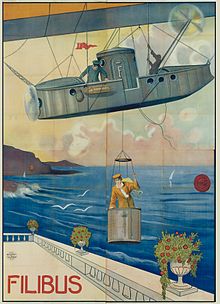 Filibus (Dir. Mario Roncoroni, It, 1915) (76mins) Filibus (the first of thirty films directed by Roncoroni) featured as a protagonist a roguish female lead character,
Filibus (Dir. Mario Roncoroni, It, 1915) (76mins) Filibus (the first of thirty films directed by Roncoroni) featured as a protagonist a roguish female lead character,  the Baroness Troixmonde, who is a respectable member of society by day, but by night in the guise of “Filibus” she terrorizes Sicily from her zeppelin, which is full of technologically-advanced equipment and weaponry. The zeppelin is manned by a staff of mask-wearing, black-skin-suit-clad male assistants who obey the Baroness’ commands instantly. The airship is her headquarters and her home, and she descends to land only to rob or to hobnob with the rich socialites and to dance with other women in the guise of the tuxedo-wearing dandy Count de la Brieve ( a full 15 years before Dietrich’s famous cross-dressing scene in Morocco). But has Filibus met her match with the renowned Detective
the Baroness Troixmonde, who is a respectable member of society by day, but by night in the guise of “Filibus” she terrorizes Sicily from her zeppelin, which is full of technologically-advanced equipment and weaponry. The zeppelin is manned by a staff of mask-wearing, black-skin-suit-clad male assistants who obey the Baroness’ commands instantly. The airship is her headquarters and her home, and she descends to land only to rob or to hobnob with the rich socialites and to dance with other women in the guise of the tuxedo-wearing dandy Count de la Brieve ( a full 15 years before Dietrich’s famous cross-dressing scene in Morocco). But has Filibus met her match with the renowned Detective 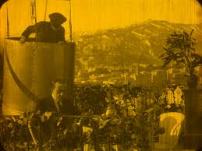 Hardy on her trail….. OK, so the ‘special effects’ are laughable by today’s standards. But this film remains hugely inventive for its time and still great fun to watch. It ends with a promise of a sequel but sadly this never materialised. See our own (with spoilers) review here or find out more at silentsplease.wordpress.com . There is a beautiful tinted version of the film here with English translations but sadly no musical accompaniment. Alternatively, the version here is plain B&W but does have musical accompaniment. And if its your only way to fully enjoy the film, with a bit of practice it is possible to sync the two in order to watch one and listen to the other!!
Hardy on her trail….. OK, so the ‘special effects’ are laughable by today’s standards. But this film remains hugely inventive for its time and still great fun to watch. It ends with a promise of a sequel but sadly this never materialised. See our own (with spoilers) review here or find out more at silentsplease.wordpress.com . There is a beautiful tinted version of the film here with English translations but sadly no musical accompaniment. Alternatively, the version here is plain B&W but does have musical accompaniment. And if its your only way to fully enjoy the film, with a bit of practice it is possible to sync the two in order to watch one and listen to the other!!
 Kid Boots (Dir. Frank Tuttle, US, 1923) ( 60 mins) Samuel (Kid) Boots (Eddie Cantor) has self image problems and sees himself as a failure with the ladies. But then he thinks his problems are over when he meets Clara McCoy (Clara Bow) who says she just wants a reliable guy rather than one that’s good looking. But he’s sidetracked by becoming involved as a witness in a messy divorce suit, finds a new friend and
Kid Boots (Dir. Frank Tuttle, US, 1923) ( 60 mins) Samuel (Kid) Boots (Eddie Cantor) has self image problems and sees himself as a failure with the ladies. But then he thinks his problems are over when he meets Clara McCoy (Clara Bow) who says she just wants a reliable guy rather than one that’s good looking. But he’s sidetracked by becoming involved as a witness in a messy divorce suit, finds a new friend and  gets a job in a health resort where he meets up again with Clara. I don’t normally warm to Eddie Cantor but in this film he is very good and Clara Bow is her usual t
gets a job in a health resort where he meets up again with Clara. I don’t normally warm to Eddie Cantor but in this film he is very good and Clara Bow is her usual t op notch self. The result is a very funny 60 minutes with many a laugh-out-loud moment. The scene with Kid Boots trying to make Clara jealous by having tea with an imaginary friend is just so clever. And with Billie Dove and Natalie Kingston also in the cast there is no shortage of glamour. Find out more at imdb.com. There are any number of versions of Kid Boots on-line but I particularly like the version from the Bill Sprague Collection on Internet Archive here which has a nice piano accompaniment from Arthur Siegel.
op notch self. The result is a very funny 60 minutes with many a laugh-out-loud moment. The scene with Kid Boots trying to make Clara jealous by having tea with an imaginary friend is just so clever. And with Billie Dove and Natalie Kingston also in the cast there is no shortage of glamour. Find out more at imdb.com. There are any number of versions of Kid Boots on-line but I particularly like the version from the Bill Sprague Collection on Internet Archive here which has a nice piano accompaniment from Arthur Siegel.
 Salome (Dir. Charles Bryant, US, 1923) (74 mins) For actor-producer Alla Nazimova, adapting Oscar Wilde’s version of Salome for the screen was a labour of love. She wrote the screenplay under the pseudonym Peter M. Winters, reportedly co-directed it and, despite being way too old at 44
Salome (Dir. Charles Bryant, US, 1923) (74 mins) For actor-producer Alla Nazimova, adapting Oscar Wilde’s version of Salome for the screen was a labour of love. She wrote the screenplay under the pseudonym Peter M. Winters, reportedly co-directed it and, despite being way too old at 44  (sources vary), made a pretty good job of starring as the youthful Salome herself. In the film, Salome tricks her step-father, King Herod, into beheading the imprisoned John the Baptist after he rejected her advances. Using much of Wilde’s original text for the inter-titles, the visual style of the film was heavily influenced by the drawings of Aubrey Beardsley which illustrated Wilde’s play on its first publication. The result is an uber-stylised production with exotic costumes and sets and a highly exaggerated acting style, more a filmed stage play than a true feature film. On Salome‘s completion, Nazimova
(sources vary), made a pretty good job of starring as the youthful Salome herself. In the film, Salome tricks her step-father, King Herod, into beheading the imprisoned John the Baptist after he rejected her advances. Using much of Wilde’s original text for the inter-titles, the visual style of the film was heavily influenced by the drawings of Aubrey Beardsley which illustrated Wilde’s play on its first publication. The result is an uber-stylised production with exotic costumes and sets and a highly exaggerated acting style, more a filmed stage play than a true feature film. On Salome‘s completion, Nazimova struggled to find a distributor and, despite some critical acclaim, it made a huge loss and effectively ended her ambitions as a film producer. But looking at it today, Salome has an ethereal and haunting beauty and is an interesting early example of what we would now call ‘art-house’ cinema. Find out more at loc.gov. There are numerous free to access on-line versions of Salome but I do like the one here on You Tube, largely on account of the modern electronic accompaniment which suits the visuals rather well.
struggled to find a distributor and, despite some critical acclaim, it made a huge loss and effectively ended her ambitions as a film producer. But looking at it today, Salome has an ethereal and haunting beauty and is an interesting early example of what we would now call ‘art-house’ cinema. Find out more at loc.gov. There are numerous free to access on-line versions of Salome but I do like the one here on You Tube, largely on account of the modern electronic accompaniment which suits the visuals rather well.
30 April
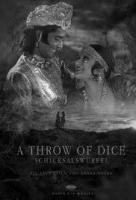 A Throw Of Dice ( aka Prapancha Pash) ) (Dir. Franz Osten, Ind, 1929) (74 mins) Inspired by the ancient Sanskrit epic poem The Mahabharata, A Throw Of Dice tells of royal cousins King Sohat (Himansu Rai) and King Ranjit (Charu Roy), a pair of inveterate gamblers. But Sohat also has ambitions on Ranjit’s throne. After a failed attempt by Sohat on Ranjit’s life the latter is nursed back to health by the beautiful Sunita (Seta Devi) with whom he falls in love. But Sohat also has designs on Sunita. Knowing Ranjit’s love of gambling, Sohat challenges him to a winner-takes-all
A Throw Of Dice ( aka Prapancha Pash) ) (Dir. Franz Osten, Ind, 1929) (74 mins) Inspired by the ancient Sanskrit epic poem The Mahabharata, A Throw Of Dice tells of royal cousins King Sohat (Himansu Rai) and King Ranjit (Charu Roy), a pair of inveterate gamblers. But Sohat also has ambitions on Ranjit’s throne. After a failed attempt by Sohat on Ranjit’s life the latter is nursed back to health by the beautiful Sunita (Seta Devi) with whom he falls in love. But Sohat also has designs on Sunita. Knowing Ranjit’s love of gambling, Sohat challenges him to a winner-takes-all  contest for his throne, for Sunita and perhaps even for his very life. But just how fair is the ‘throw of dice’! Shot on location in Rajasthan,A Throw Of Dice features over 10,000 extras and an impressive array of horses, elephants and tigers. The film is stunning to look at, the location shooting is breathtaking and the performances exceptional. A Throw of Dice was the third film, after Light of Asia (1925) and Shiraz (1928), in a pioneering trilogy of silent
contest for his throne, for Sunita and perhaps even for his very life. But just how fair is the ‘throw of dice’! Shot on location in Rajasthan,A Throw Of Dice features over 10,000 extras and an impressive array of horses, elephants and tigers. The film is stunning to look at, the location shooting is breathtaking and the performances exceptional. A Throw of Dice was the third film, after Light of Asia (1925) and Shiraz (1928), in a pioneering trilogy of silent  films made in a partnership between German director Franz Osten, Indian actor-producer Himansu Rai, and writer Niranjan Pal . Together with actress Devika Rani they would go on to establish the Bombay Talkies studio in 1934 setting in train the rise of Bollywood. This trilogy of films made a huge star of Anglo-Indian actress Seta Devi (born plain old Renee Smith) but she herself failed to make the transition to ‘talkies’. Find out more at silentfilm.org. The version here on You Tube is the beautifully restored version released by Kino with a lovely accompaniment composed by Nitin Sawhney. (PS Don’t worry that the You Tube version gives a running time of 2 hours and 32 minutes, for some reason the film runs twice.)
films made in a partnership between German director Franz Osten, Indian actor-producer Himansu Rai, and writer Niranjan Pal . Together with actress Devika Rani they would go on to establish the Bombay Talkies studio in 1934 setting in train the rise of Bollywood. This trilogy of films made a huge star of Anglo-Indian actress Seta Devi (born plain old Renee Smith) but she herself failed to make the transition to ‘talkies’. Find out more at silentfilm.org. The version here on You Tube is the beautifully restored version released by Kino with a lovely accompaniment composed by Nitin Sawhney. (PS Don’t worry that the You Tube version gives a running time of 2 hours and 32 minutes, for some reason the film runs twice.)
29 April
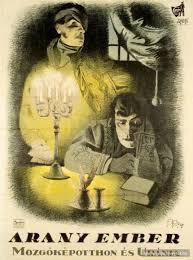 Man Of Gold (aka Az aranyember, aka The Red Half Moon) (Dir. Sándor Korda, Hun, 1918) (85 mins) When an arrest warrant is issued for a rich Turkish pasha he escapes with his daughter Kondja (Magrit Makay) and a sack of treasure on a ship
Man Of Gold (aka Az aranyember, aka The Red Half Moon) (Dir. Sándor Korda, Hun, 1918) (85 mins) When an arrest warrant is issued for a rich Turkish pasha he escapes with his daughter Kondja (Magrit Makay) and a sack of treasure on a ship 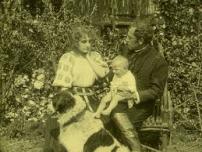 traveling up the River Danube. But when he is followed by a police spy he commits suicide after entrusting Timar (Oszkar Beregi) the ship’s captain with ensuring his daughter’s safety and providing her with money from the treasure. But Beregi keeps the money becoming a prosperous titled businessman, eventually marrying Kondja but also continuing a relationship with peasant girl Noemi. But the police spy is now on his trail. Man of Gold is a sprawling melodrama, a story of deception, guilt, blackmail and revenge. It features some stunning
traveling up the River Danube. But when he is followed by a police spy he commits suicide after entrusting Timar (Oszkar Beregi) the ship’s captain with ensuring his daughter’s safety and providing her with money from the treasure. But Beregi keeps the money becoming a prosperous titled businessman, eventually marrying Kondja but also continuing a relationship with peasant girl Noemi. But the police spy is now on his trail. Man of Gold is a sprawling melodrama, a story of deception, guilt, blackmail and revenge. It features some stunning  location photography on the River Danube at the Iron Gate gorge as well as impressive studio interiors, particularly of the Pasha’s palace. The film is beautifully restored and some of the scenes, particularly the red tinted ones are stunningly attractive. Probably still missing some original footage the plot is occasionally a little tricky to follow while the overly theatrical acting style reflects the era it was made in. Director Sandor Korda of course changed his name on leaving Hungary to Alexander Korda, in the process becoming one of the biggest names in British cinema. The film is available to watch here courtesy of the Hungarian Film Archive. Unfortunately there is no musical accompaniment.
location photography on the River Danube at the Iron Gate gorge as well as impressive studio interiors, particularly of the Pasha’s palace. The film is beautifully restored and some of the scenes, particularly the red tinted ones are stunningly attractive. Probably still missing some original footage the plot is occasionally a little tricky to follow while the overly theatrical acting style reflects the era it was made in. Director Sandor Korda of course changed his name on leaving Hungary to Alexander Korda, in the process becoming one of the biggest names in British cinema. The film is available to watch here courtesy of the Hungarian Film Archive. Unfortunately there is no musical accompaniment.
 A Trip to Mars (aka Das Himmelschiff) (Dir. Forest Holger-Madsen, Den, 1918) (81 mins) Made near the end of the ‘golden age’ of Danish cinema, A Trip To Mars is probably the first feature length science fiction film ever made. Inspired by his astronomer father, naval captain
A Trip to Mars (aka Das Himmelschiff) (Dir. Forest Holger-Madsen, Den, 1918) (81 mins) Made near the end of the ‘golden age’ of Danish cinema, A Trip To Mars is probably the first feature length science fiction film ever made. Inspired by his astronomer father, naval captain  Avanti Planetaros ( Gunnar Tolnaes) builds a spaceship and assembles a crew for a long journey to Mars. On arrival he discovers an advanced race of people, free from the scourges of hunger, disease or violence (and vegetarian to boot!). Avanti of course falls for the Martian leader’s daughter (Lilly Jacobson) but trouble looms when the earth men display their true character (“We come in peace” but they all have guns tucked in our belts!). This idea of advanced, peaceful alien versus crude, violent human would of course be a recurrent theme in science fiction film and TV right up to the present day. The film itself has considerable production values with a huge cast, impressive costumes and some giant
Avanti Planetaros ( Gunnar Tolnaes) builds a spaceship and assembles a crew for a long journey to Mars. On arrival he discovers an advanced race of people, free from the scourges of hunger, disease or violence (and vegetarian to boot!). Avanti of course falls for the Martian leader’s daughter (Lilly Jacobson) but trouble looms when the earth men display their true character (“We come in peace” but they all have guns tucked in our belts!). This idea of advanced, peaceful alien versus crude, violent human would of course be a recurrent theme in science fiction film and TV right up to the present day. The film itself has considerable production values with a huge cast, impressive costumes and some giant 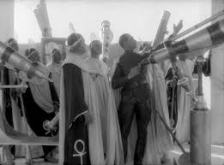 sets. While its easy now to laugh at the technology on show (a spaceship with wings and a propeller which ‘flies’ to Mars, astronauts clad in leather flying jackets etc) the scientific conception of space travel was not then even in its infancy. The other interesting theme of the film is the utopian and peaceful
sets. While its easy now to laugh at the technology on show (a spaceship with wings and a propeller which ‘flies’ to Mars, astronauts clad in leather flying jackets etc) the scientific conception of space travel was not then even in its infancy. The other interesting theme of the film is the utopian and peaceful  nature of martian society, which, despite its obvious naivety, was perhaps easy to understand in a film made as the slaughter of the 1914-18 war was drawing to a close and there was an idealistic hope of a better world to follow. All in all, A Trip To Mars is a fascinating film, enjoyable despite, or perhaps in part even because of, some of the worst ‘ham’ acting. It was also good to see the perpetually doubtful Professor Dubius (gettit!) get his come-uppance at the film’s conclusion. Find out more at horrornews.net. The film can be watched here in a beautifully restored version courtesy of the Danish Film Archive with English translations and a pleasant piano accompaniment.
nature of martian society, which, despite its obvious naivety, was perhaps easy to understand in a film made as the slaughter of the 1914-18 war was drawing to a close and there was an idealistic hope of a better world to follow. All in all, A Trip To Mars is a fascinating film, enjoyable despite, or perhaps in part even because of, some of the worst ‘ham’ acting. It was also good to see the perpetually doubtful Professor Dubius (gettit!) get his come-uppance at the film’s conclusion. Find out more at horrornews.net. The film can be watched here in a beautifully restored version courtesy of the Danish Film Archive with English translations and a pleasant piano accompaniment.
28 April
 Jiraiya The Hero (aka Goketsu Jiraiya) (Dir. Shozo Makino, Jap, 1921 (21 mins) Although indigenous film production had begun in Japan by the late 1890s, for a film made in 1921 Jiraiya The Hero is a technically crude and simplistic work, with static camera work, extended long-shot takes, few close ups and minimal editing. Parts of it are curiously reminiscent of the work of Melies or Segundo de Chomón from well over a decade earlier. Although director Shōzō Makino is regarded as the
Jiraiya The Hero (aka Goketsu Jiraiya) (Dir. Shozo Makino, Jap, 1921 (21 mins) Although indigenous film production had begun in Japan by the late 1890s, for a film made in 1921 Jiraiya The Hero is a technically crude and simplistic work, with static camera work, extended long-shot takes, few close ups and minimal editing. Parts of it are curiously reminiscent of the work of Melies or Segundo de Chomón from well over a decade earlier. Although director Shōzō Makino is regarded as the  first pioneer of Japanese cinema, his forte was period drama or jidaigeki. Unlike in the west where the new medium of film was seen as entertainment for the working class, in Japan the reverse was true with the new medium being championed by the upper classes, who wanted film to recreate the period Kabuki stage plays they favoured. It was not until the early 1920s that the rival contemporary film or gendaigeki genre began to emerge. Jiraiya The Hero certainly falls into the period drama category. It also lacks much of a narrative plot, with minimal inter-titles. However, as was common in early Japanese silent film, it would rely on a benshi narrator to explain and further dramatise aspects of the plot. Nevertheless, the film is interesting for its trick photography (the lead character turning into a giant toad to fight a serpent) and its stylised Samuri sword play. And for all the hundreds of films Shozo Makino directed this may be one of just two to have survived. The film can be viewed here at the South Asia On-Line Film Festival website, which also has some more information about the film.
first pioneer of Japanese cinema, his forte was period drama or jidaigeki. Unlike in the west where the new medium of film was seen as entertainment for the working class, in Japan the reverse was true with the new medium being championed by the upper classes, who wanted film to recreate the period Kabuki stage plays they favoured. It was not until the early 1920s that the rival contemporary film or gendaigeki genre began to emerge. Jiraiya The Hero certainly falls into the period drama category. It also lacks much of a narrative plot, with minimal inter-titles. However, as was common in early Japanese silent film, it would rely on a benshi narrator to explain and further dramatise aspects of the plot. Nevertheless, the film is interesting for its trick photography (the lead character turning into a giant toad to fight a serpent) and its stylised Samuri sword play. And for all the hundreds of films Shozo Makino directed this may be one of just two to have survived. The film can be viewed here at the South Asia On-Line Film Festival website, which also has some more information about the film.
27 April
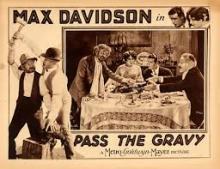 Pass The Gravy (Dir. Leo McCarey, US, 1928) (25 mins) The story of a prize rooster, battling neighbours, an engagement party and a bird roasting in the
Pass The Gravy (Dir. Leo McCarey, US, 1928) (25 mins) The story of a prize rooster, battling neighbours, an engagement party and a bird roasting in the  oven. An almost perfect comedy but then what would you expect from the Hal Roach studio, direction supervised by Leo McCarey and starring Max Davidson. Davidson is excellent as is Spec O’Donnell playing his usual geeky kid but for me its Gene Morgan and Martha Sleeper who steal the film, especially with their extended ‘charades’ scene. Find out more at loc.gov. A version on You Tube with nice accompaniment is here
oven. An almost perfect comedy but then what would you expect from the Hal Roach studio, direction supervised by Leo McCarey and starring Max Davidson. Davidson is excellent as is Spec O’Donnell playing his usual geeky kid but for me its Gene Morgan and Martha Sleeper who steal the film, especially with their extended ‘charades’ scene. Find out more at loc.gov. A version on You Tube with nice accompaniment is here
 True Heart Susie (Dir. D W Griffith, US, 1919) (86 mins) True Heart Susie is probably my favourite film from director D W Griffith. The complete antithesis of his epic productions such as Birth of a Nation or Intolerance, it is an intimate little drama,
True Heart Susie (Dir. D W Griffith, US, 1919) (86 mins) True Heart Susie is probably my favourite film from director D W Griffith. The complete antithesis of his epic productions such as Birth of a Nation or Intolerance, it is an intimate little drama,  one of Griffith’s ‘pastoral’ films, a rural poem seemingly harking back to an earlier age. The plain and simple Susie (Lillian Gish) is in love with neighbour William (Robert Harron) but he’s too bashful to take things further. When a lack of funds prevents his going to college, Susie anonymously sends him the money, hoping that they will be married on his return. But the William that returns is not the one who went away and heartbreak is in store for Susie. OK, so the story is curiously old fashioned, perhaps a little over-sentimental and one or two of the inter-titles grate with a modern audience but the film is just so charming. Lillian Gish puts in her usual knock-out performance but Robert Harron is almost as
one of Griffith’s ‘pastoral’ films, a rural poem seemingly harking back to an earlier age. The plain and simple Susie (Lillian Gish) is in love with neighbour William (Robert Harron) but he’s too bashful to take things further. When a lack of funds prevents his going to college, Susie anonymously sends him the money, hoping that they will be married on his return. But the William that returns is not the one who went away and heartbreak is in store for Susie. OK, so the story is curiously old fashioned, perhaps a little over-sentimental and one or two of the inter-titles grate with a modern audience but the film is just so charming. Lillian Gish puts in her usual knock-out performance but Robert Harron is almost as  good, particularly upon his return from college. Tragically Harron was to die the following year from a self inflicted gunshot in still unclear circumstances. A big star at the time, he is now all but forgotten. And watch out for Clarine Seymore, his flirty wife, who would utter the word ‘damn’ a full twenty years before Rhett Butler caused such a fuss when he said it. Find out more at silentsaregolden.com. There is a good quality version on You Tube here (far better in fact than the version I purchased on DVD!!) which also comes with the benefit of beautiful accompaniment from…..well, I’d love to know who!
good, particularly upon his return from college. Tragically Harron was to die the following year from a self inflicted gunshot in still unclear circumstances. A big star at the time, he is now all but forgotten. And watch out for Clarine Seymore, his flirty wife, who would utter the word ‘damn’ a full twenty years before Rhett Butler caused such a fuss when he said it. Find out more at silentsaregolden.com. There is a good quality version on You Tube here (far better in fact than the version I purchased on DVD!!) which also comes with the benefit of beautiful accompaniment from…..well, I’d love to know who!
 Queen Of Sports (Dir. Sun Yu, Chi, 1934) (89 mins) Films about women’s sport are rare enough now let alone 75 years ago, but that is what we have here, the story of a high-spirited and talented but untrained runner, Lin Ying (Li Li-Li) who arrives in Shanghai to attend a sports academy. Here Lin Ying excels, much to the annoyance of the academy’s more established stars, who plot against her. And amidst the high life of the big city Lin Ying is in
Queen Of Sports (Dir. Sun Yu, Chi, 1934) (89 mins) Films about women’s sport are rare enough now let alone 75 years ago, but that is what we have here, the story of a high-spirited and talented but untrained runner, Lin Ying (Li Li-Li) who arrives in Shanghai to attend a sports academy. Here Lin Ying excels, much to the annoyance of the academy’s more established stars, who plot against her. And amidst the high life of the big city Lin Ying is in  danger of loosing her commitment to her athletic ambitions. By the time of this film actress Li Li-Li was already a major star of Chinese cinema and this part was written specifically for her and epitomises her own high-spirited character, reminiscent of a Chinese Clara Bow, not least at the film’s opening when she climbs the ship’s funnel to get a better look at Shanghai. Li Li-Li continued to act until the
danger of loosing her commitment to her athletic ambitions. By the time of this film actress Li Li-Li was already a major star of Chinese cinema and this part was written specifically for her and epitomises her own high-spirited character, reminiscent of a Chinese Clara Bow, not least at the film’s opening when she climbs the ship’s funnel to get a better look at Shanghai. Li Li-Li continued to act until the  1940s after which she taught at the Beijing Film Academy. During the cultural revolution she was denounced and tortured (and her husband executed) on the orders of Chairman Mao’s wife Jiang Qing who had been an acting contemporary of Li Li-Li’s but who had never achieved the same degree of stardom. Whilst the film is a highly entertaining and well made fiction it was also intended to carry a propaganda message, heralding the benefits of physical fitness, sportsmanship, even dental hygiene! Find out more at vcinemashow.com. The You Tube version hereis of pretty good quality and, although it is not a bespoke accompaniment (which at times sounds reminiscent of Philip Glass), it fits quite well.
1940s after which she taught at the Beijing Film Academy. During the cultural revolution she was denounced and tortured (and her husband executed) on the orders of Chairman Mao’s wife Jiang Qing who had been an acting contemporary of Li Li-Li’s but who had never achieved the same degree of stardom. Whilst the film is a highly entertaining and well made fiction it was also intended to carry a propaganda message, heralding the benefits of physical fitness, sportsmanship, even dental hygiene! Find out more at vcinemashow.com. The You Tube version hereis of pretty good quality and, although it is not a bespoke accompaniment (which at times sounds reminiscent of Philip Glass), it fits quite well.
25 April
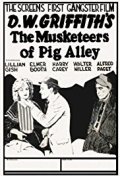 The Musketeers of Pig Alley (Dir. D W Griffith, US, 1912) (17 mins) While her musician boyfriend is away, the neighborhood gangster, the ‘snapper kid’ (Elmer Booth), tries to make a move on the ‘little lady’ (Lillian Gish). Despite being rebuffed he maintains an interest in her but has bigger issues to deal with in the form of a rival gang. For just a 17 minute film, The Musketeers of Pig Alley really does pack a lot in. The central protagonists, particularly the
The Musketeers of Pig Alley (Dir. D W Griffith, US, 1912) (17 mins) While her musician boyfriend is away, the neighborhood gangster, the ‘snapper kid’ (Elmer Booth), tries to make a move on the ‘little lady’ (Lillian Gish). Despite being rebuffed he maintains an interest in her but has bigger issues to deal with in the form of a rival gang. For just a 17 minute film, The Musketeers of Pig Alley really does pack a lot in. The central protagonists, particularly the 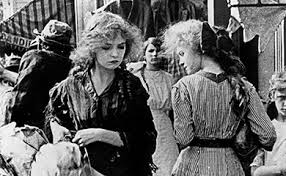 Snapper Kid and the Little Lady are fully fleshed out and believable characters rather than mere one-dimensional cyphers. Although the build up to the shoot-out out, as the two gangs stalk each other, lasts perhaps only three minutes of screen time, it elicits a genuine tension and the gunfight when it comes is dramatic in both its physical compactness and its intensity. The film is beautifully shot (by Billy Bitzer) and is rightly famed for the
Snapper Kid and the Little Lady are fully fleshed out and believable characters rather than mere one-dimensional cyphers. Although the build up to the shoot-out out, as the two gangs stalk each other, lasts perhaps only three minutes of screen time, it elicits a genuine tension and the gunfight when it comes is dramatic in both its physical compactness and its intensity. The film is beautifully shot (by Billy Bitzer) and is rightly famed for the  dramatic close up of the Snapper Kid as he creeps along a wall to stare out directly at the audience. Lillian Gish would of course go on to a stellar film career but sadly Elmer Booth would die just three years later, a passenger in a car driven by an intoxicated Tod Browning which collided with a freight train. Find out more about The Musketeers of Pig Alley at moma.org. There are several versions of the film on You Tube such as the one here, all seemingly drawn from the same original. Sadly, all of them are let down by bland and inappropriate accompaniment. You’d be better off turning the sound down for this one!.
dramatic close up of the Snapper Kid as he creeps along a wall to stare out directly at the audience. Lillian Gish would of course go on to a stellar film career but sadly Elmer Booth would die just three years later, a passenger in a car driven by an intoxicated Tod Browning which collided with a freight train. Find out more about The Musketeers of Pig Alley at moma.org. There are several versions of the film on You Tube such as the one here, all seemingly drawn from the same original. Sadly, all of them are let down by bland and inappropriate accompaniment. You’d be better off turning the sound down for this one!.
 The Oyster Princess (aka Die Austernprinzessin) (Dir. Ernst Lubitsch, Ger, 1919) (60 mins) When Ossi (Ossi Oswaldo), the uber spoilt daughter of Oyster millionaire businessman Mr Quaker, learns that one of her friends is marrying a count she throws a mega tantrum and demands that she immediately be married to a prince. The chosen groom is the destitute Prince Nucki. But first,
The Oyster Princess (aka Die Austernprinzessin) (Dir. Ernst Lubitsch, Ger, 1919) (60 mins) When Ossi (Ossi Oswaldo), the uber spoilt daughter of Oyster millionaire businessman Mr Quaker, learns that one of her friends is marrying a count she throws a mega tantrum and demands that she immediately be married to a prince. The chosen groom is the destitute Prince Nucki. But first,  the prince sends his valet to check whether his bride-to-be measures up. And that is where things start to go wrong. Before anyone had ever dreamed up the phrase ‘The Lubitsch Touch‘ here was a film positively overflowing with the director’s renowned style. The story, the sets, the performances, the timing, the fluidity of movement, its all there and adds up to a riotously funny sixty minutes. Ossi Oswalde portrays the hyper impatient spoilt teenager to a tee, rarely more than a heartbeat away from the next
the prince sends his valet to check whether his bride-to-be measures up. And that is where things start to go wrong. Before anyone had ever dreamed up the phrase ‘The Lubitsch Touch‘ here was a film positively overflowing with the director’s renowned style. The story, the sets, the performances, the timing, the fluidity of movement, its all there and adds up to a riotously funny sixty minutes. Ossi Oswalde portrays the hyper impatient spoilt teenager to a tee, rarely more than a heartbeat away from the next  destructive tantrum. Yet as Lubitsch’s career was to soar, hers was to fade even before the end of the silent era and she died in poverty in Prague in 1947 aged just 50. Find out more at sensesofcinema.com. The version available on You Tube here looks to be the same as that included on the Lubitsch In Berlin DVD collection, with beautiful reproduction and a fine accompaniment.
destructive tantrum. Yet as Lubitsch’s career was to soar, hers was to fade even before the end of the silent era and she died in poverty in Prague in 1947 aged just 50. Find out more at sensesofcinema.com. The version available on You Tube here looks to be the same as that included on the Lubitsch In Berlin DVD collection, with beautiful reproduction and a fine accompaniment.
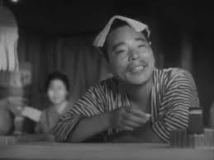 Passing Fancy (Dir. Yasujiro Ozu, Jap, 1933) (100 mins) On their way home after a night out two brewery workers, Kihachi (Takeshi Sakamoto ) and his younger friend Jiro (Den Obinata ), come across a destitute young woman, Harue (Nobuko Fushimi). Against Jiro’s better judgement Kihachi finds her somewhere to stay. He has dreams of marrying her but Harue is interested
Passing Fancy (Dir. Yasujiro Ozu, Jap, 1933) (100 mins) On their way home after a night out two brewery workers, Kihachi (Takeshi Sakamoto ) and his younger friend Jiro (Den Obinata ), come across a destitute young woman, Harue (Nobuko Fushimi). Against Jiro’s better judgement Kihachi finds her somewhere to stay. He has dreams of marrying her but Harue is interested  only in Jiro. Although tinged with melodrama, Passing Fancy is at heart a charming light comedy. While structured around the Kihachi/Jiro/Harue triangle, the film is as much about the relationship between the illiterate Kihachi and his cleverer school boy son Tomio (with another remarkable performance by Tokkan Kozo). The year 1933 saw director Ozu hit a particular vein of form, making not only
only in Jiro. Although tinged with melodrama, Passing Fancy is at heart a charming light comedy. While structured around the Kihachi/Jiro/Harue triangle, the film is as much about the relationship between the illiterate Kihachi and his cleverer school boy son Tomio (with another remarkable performance by Tokkan Kozo). The year 1933 saw director Ozu hit a particular vein of form, making not only  Passing Fancy but also Dragnet Girl and Woman Of Tokyo. Although Sakamoto had been a regular in previous Ozu films, this was his first starring role and he would go on to reprise the Kihachi character in two further films. Tokkan Kozo made his screen debut aged just six in 1929 and by the time of Passing Fancy was already a forty film veteran. He would eventually appear in over 150 films, the last in 2004. Find out more about Passing Fancy at sensesofcinema.com. The You Tube version of the film here has some short periods of nitrate damage but is otherwise of very good quality. Accompaniment is in the form of a compilation of Japanese songs which, although they don’t always exactly match the tone of the on screen events, do provide a pleasing background.
Passing Fancy but also Dragnet Girl and Woman Of Tokyo. Although Sakamoto had been a regular in previous Ozu films, this was his first starring role and he would go on to reprise the Kihachi character in two further films. Tokkan Kozo made his screen debut aged just six in 1929 and by the time of Passing Fancy was already a forty film veteran. He would eventually appear in over 150 films, the last in 2004. Find out more about Passing Fancy at sensesofcinema.com. The You Tube version of the film here has some short periods of nitrate damage but is otherwise of very good quality. Accompaniment is in the form of a compilation of Japanese songs which, although they don’t always exactly match the tone of the on screen events, do provide a pleasing background.
24 April
 Cosmic Voyage (aka Kosmicheskiy Reys: Fantasticheskaya Novella) (Dir. Vasili Zhuravlov, USSR, 1936) Cosmic Voyage is just such a fun film, in a Gerry
Cosmic Voyage (aka Kosmicheskiy Reys: Fantasticheskaya Novella) (Dir. Vasili Zhuravlov, USSR, 1936) Cosmic Voyage is just such a fun film, in a Gerry  Anderson/Fireball XL5 sort of way. A silent made well into the sound era, it details the first manned mission to the moon, piloted by an eccentric scientist, his glamorous female assistant and a precocious small boy. The film is a curious mix of escapist entertainment and (for its time) extant scientific knowledge. Sponsored by the Soviet Komsomol youth league in order to foster an interest amongst adolescents in space science it also benefited from technical advice from Konstantin Tsiolkovsky, a noted Soviet aeronautical theorist and rocket science engineer. The film is a mix of live action and animation with some impressive special effects, superb model work and grandiose set design. Sadly, despite considerable popular success on its initial release, Cosmic Voyage subsequently fell
Anderson/Fireball XL5 sort of way. A silent made well into the sound era, it details the first manned mission to the moon, piloted by an eccentric scientist, his glamorous female assistant and a precocious small boy. The film is a curious mix of escapist entertainment and (for its time) extant scientific knowledge. Sponsored by the Soviet Komsomol youth league in order to foster an interest amongst adolescents in space science it also benefited from technical advice from Konstantin Tsiolkovsky, a noted Soviet aeronautical theorist and rocket science engineer. The film is a mix of live action and animation with some impressive special effects, superb model work and grandiose set design. Sadly, despite considerable popular success on its initial release, Cosmic Voyage subsequently fell  foul of Soviet censors and was pulled from circulation. It was rediscovered in the 1980s but remains little known and rarely screened, which
foul of Soviet censors and was pulled from circulation. It was rediscovered in the 1980s but remains little known and rarely screened, which  is a real shame as it really deserves greater recognition as a significant way-point in the development of the science fiction film genre. Find out more at silentfilm.org and 1000misspenthours.com. The version on You Tube here with English language translations of the inter-titles comes with an orchestral score that doesn’t seem to have been written for the film but fits quite nicely. Alternatively, if you’re OK reading cyrillic then the version here has a more atmospheric modern electronic accompaniment.
is a real shame as it really deserves greater recognition as a significant way-point in the development of the science fiction film genre. Find out more at silentfilm.org and 1000misspenthours.com. The version on You Tube here with English language translations of the inter-titles comes with an orchestral score that doesn’t seem to have been written for the film but fits quite nicely. Alternatively, if you’re OK reading cyrillic then the version here has a more atmospheric modern electronic accompaniment.
 Mothers Of Men (Dir. Willis L. Robards, US, 1917) (60 mins) Mothers Of Men is one of the few surviving suffragist films, made to promote the idea of women’s suffrage at a time when women in the US were still denied the vote. In the film, Clara Madison (Dorothy Davenport) is elected first as a judge and then state governor. When her husband is accused and then found guilty of a serious crime she has the power as governor to commute his
Mothers Of Men (Dir. Willis L. Robards, US, 1917) (60 mins) Mothers Of Men is one of the few surviving suffragist films, made to promote the idea of women’s suffrage at a time when women in the US were still denied the vote. In the film, Clara Madison (Dorothy Davenport) is elected first as a judge and then state governor. When her husband is accused and then found guilty of a serious crime she has the power as governor to commute his  sentence but only at the risk of being accused of using her office for personal gain. While not a straight plea for women’s suffrage, the film sought to address the question of whether women had what it took to hold political office. Although Mothers Of Men poses this interesting question it plays out more as something of a cloying melodrama and the finale is a complete cop-out. Nevertheless, made two years before women even got the vote, its an interesting take on women’s rights. Additionally, this restoration, from the team at the San Francisco Silent Film Festival is absolutely stunning. Find out more at silentfilm.org. The film is available here via Vimeo with musical accompaniment from the Mont Alto Motion Picture Orchestra.
sentence but only at the risk of being accused of using her office for personal gain. While not a straight plea for women’s suffrage, the film sought to address the question of whether women had what it took to hold political office. Although Mothers Of Men poses this interesting question it plays out more as something of a cloying melodrama and the finale is a complete cop-out. Nevertheless, made two years before women even got the vote, its an interesting take on women’s rights. Additionally, this restoration, from the team at the San Francisco Silent Film Festival is absolutely stunning. Find out more at silentfilm.org. The film is available here via Vimeo with musical accompaniment from the Mont Alto Motion Picture Orchestra.
 The Battling Butler (Dir. Buster Keaton, US, 1926) (77 mins) Although it may not quite live up to the standards of The General or Steamboat Bill Jr, I’ve got a lot of time for The Battling Butler (and Buster himself apparently regarded it as one of favourites). Buster plays Alfred Butler, milksop son of a rich
The Battling Butler (Dir. Buster Keaton, US, 1926) (77 mins) Although it may not quite live up to the standards of The General or Steamboat Bill Jr, I’ve got a lot of time for The Battling Butler (and Buster himself apparently regarded it as one of favourites). Buster plays Alfred Butler, milksop son of a rich  businessman who sends him on a hunting trip in the hope it will make a man of his son. But along the way Alfred is mistaken for ‘Battling’ Butler, a champion boxer and chaos ensues. Buster is as usual on top form, especially with the more extreme physical
businessman who sends him on a hunting trip in the hope it will make a man of his son. But along the way Alfred is mistaken for ‘Battling’ Butler, a champion boxer and chaos ensues. Buster is as usual on top form, especially with the more extreme physical 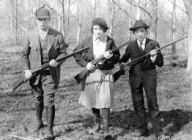 comedy (and in some of Buster’s boxing scenes the fighters certainly weren’t pulling their punches) and Snitz Edwards is great as his humourless, loyal but too-clever-for-his-own-good valet, always ready to “Arrange it” at a word from his boss. Find out more at moviemovieblogblog.wordpress.com. The version on You Tube here is a nice restoration from the US Library of Congress with an OK organ accompaniment.
comedy (and in some of Buster’s boxing scenes the fighters certainly weren’t pulling their punches) and Snitz Edwards is great as his humourless, loyal but too-clever-for-his-own-good valet, always ready to “Arrange it” at a word from his boss. Find out more at moviemovieblogblog.wordpress.com. The version on You Tube here is a nice restoration from the US Library of Congress with an OK organ accompaniment.
22 April
 An Inn In Tokyo (Dir. Yasujiro Ozu, Jap, 1935) (80 mins) Director Ozu’s genius lay not only in turning out one film gem after another but also in being able to master virtually any cinematic genre, from his student comedies, to the social drama of I Was Born But… to the gangsterism of Dragnet Girl. And with An Inn In Tokyo he produces an amazing slice of neo-realism well over a decade before the likes of Rossellini , Visconti or De Sica believed they had originated the genre. As the destitute Kihachi and his two sons wander a grim industrial landscape looking for work, they come across the equally desperate Otaka and her sick
An Inn In Tokyo (Dir. Yasujiro Ozu, Jap, 1935) (80 mins) Director Ozu’s genius lay not only in turning out one film gem after another but also in being able to master virtually any cinematic genre, from his student comedies, to the social drama of I Was Born But… to the gangsterism of Dragnet Girl. And with An Inn In Tokyo he produces an amazing slice of neo-realism well over a decade before the likes of Rossellini , Visconti or De Sica believed they had originated the genre. As the destitute Kihachi and his two sons wander a grim industrial landscape looking for work, they come across the equally desperate Otaka and her sick  daughter . An act of kindness enables Kihachi to find work but, as always in neo-realism, further despair is just around the corner. This perhaps lesser known of Ozu’s silent films is probably also one of his bleakest, perfectly capturing the despair of poverty and unemployment. As always Ozu draws out incredible performances for all of his cast, not least the children, including Tokkan Kozo who was so good in I Was Born But… Playing the part of Otaka, Yoshiko Okada’s life story
daughter . An act of kindness enables Kihachi to find work but, as always in neo-realism, further despair is just around the corner. This perhaps lesser known of Ozu’s silent films is probably also one of his bleakest, perfectly capturing the despair of poverty and unemployment. As always Ozu draws out incredible performances for all of his cast, not least the children, including Tokkan Kozo who was so good in I Was Born But… Playing the part of Otaka, Yoshiko Okada’s life story  itself had all the makings of film melodrama. Escaping increasingly right wing pre-war Japan with her left leaning partner they sought refuge in the Soviet Union but were then caught up in the Stalinist purges. Her partner was shot as a spy while she spent a decade in the Gulag. Eventually released she managed to remake a career in Soviet film and theatre direction before returning to Japan in the 1970s to resume her acting career. Finally, perestroika allowed her return to Russia where she died in 1992. Find out more about An Inn In Tokyo at wondersinthedark.wordpress.com. The version available to watch on You Tube here is of reasonable quality, well sub-titled and with an appropriate (albeit somewhat one-dimensional) accompaniment.
itself had all the makings of film melodrama. Escaping increasingly right wing pre-war Japan with her left leaning partner they sought refuge in the Soviet Union but were then caught up in the Stalinist purges. Her partner was shot as a spy while she spent a decade in the Gulag. Eventually released she managed to remake a career in Soviet film and theatre direction before returning to Japan in the 1970s to resume her acting career. Finally, perestroika allowed her return to Russia where she died in 1992. Find out more about An Inn In Tokyo at wondersinthedark.wordpress.com. The version available to watch on You Tube here is of reasonable quality, well sub-titled and with an appropriate (albeit somewhat one-dimensional) accompaniment.
 The Sentimental Bloke (Dir. Raymond Longford, Aust, 1919) (68 Mins) Set in the working class Woolloomooloo district of Sydney, Bill (Arthur Tauchert ) is a larrikin, a bit of a ne’er-do-well, fond of a drink and a gamble. But when he meets Doreen
The Sentimental Bloke (Dir. Raymond Longford, Aust, 1919) (68 Mins) Set in the working class Woolloomooloo district of Sydney, Bill (Arthur Tauchert ) is a larrikin, a bit of a ne’er-do-well, fond of a drink and a gamble. But when he meets Doreen 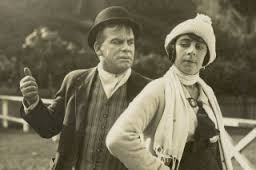 (Lottie Lyell) he promises to give up the drink and become respectable if she will marry him. But the road to true love is one that proves difficult to follow. The Sentimental Bloke was the most successful silent film made in Australia and its not difficult to see why. Yes, the story may be sentimental but it never strays into mawkishness and it is full of humour (in particular Bill’s introduction to Shakespeare and the stress of afternoon tea with his prospective mother-in-law) . The acting by Tauchert and Lyell is top notch. This was only Tauchert’s second film after a long career in vaudeville and he went on to a hugely successful film career before his death in 1933. In contrast, Lyell had already achieved considerable success, not only as actress but as screenwriter, editor and director, working in partnership (both professional and romantic) with director Longford
(Lottie Lyell) he promises to give up the drink and become respectable if she will marry him. But the road to true love is one that proves difficult to follow. The Sentimental Bloke was the most successful silent film made in Australia and its not difficult to see why. Yes, the story may be sentimental but it never strays into mawkishness and it is full of humour (in particular Bill’s introduction to Shakespeare and the stress of afternoon tea with his prospective mother-in-law) . The acting by Tauchert and Lyell is top notch. This was only Tauchert’s second film after a long career in vaudeville and he went on to a hugely successful film career before his death in 1933. In contrast, Lyell had already achieved considerable success, not only as actress but as screenwriter, editor and director, working in partnership (both professional and romantic) with director Longford 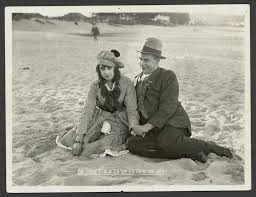 and their jointly run Southern Cross Feature Film Co . She is yet another almost forgotten female pioneer of silent film, about which more can be found here. Sadly her career was cut short with her early death from TB in 1925. The other delight of the film is the use of original text from the source material, C.J. Dennis’ 1915 poem The Songs of a Sentimental Bloke, with the inter-titles all written in vernacular ‘Australian’ (and beautifully illustrated). They can be a bit tricky to read to start with but you soon pick it up. Find out more here. The You Tube version to watch here isn’t the best of quality but it is watchable. It also suffers from a plinkity-plink type piano accompaniment set on repeat which could induce madness within about 30 minutes if not muted. However, look out for the UK premier of a stunning new restoration of The Sentimental Bloke at the hopefully soon to be re-scheduled Hippodrome Silent Film Festival.
and their jointly run Southern Cross Feature Film Co . She is yet another almost forgotten female pioneer of silent film, about which more can be found here. Sadly her career was cut short with her early death from TB in 1925. The other delight of the film is the use of original text from the source material, C.J. Dennis’ 1915 poem The Songs of a Sentimental Bloke, with the inter-titles all written in vernacular ‘Australian’ (and beautifully illustrated). They can be a bit tricky to read to start with but you soon pick it up. Find out more here. The You Tube version to watch here isn’t the best of quality but it is watchable. It also suffers from a plinkity-plink type piano accompaniment set on repeat which could induce madness within about 30 minutes if not muted. However, look out for the UK premier of a stunning new restoration of The Sentimental Bloke at the hopefully soon to be re-scheduled Hippodrome Silent Film Festival.
21 April
 Menilmontant (Dir. Dimitri Kirsanoff,Fr, 1926) (37 mins) How do you categorize Menilmontant? IMDb summarises it thus, “A couple is brutally murdered in the working-class district of Paris. Later on, the narrative follows the lives of their two daughters, both in love with a Parisian thug and leading them to separate ways”, which barely scratches the surface of what the film is about. Is it a Vertov like montage or a Parisian ‘city symphony; a psychological melodrama or a murder mystery; surrealist or avant garde? Well, it could be all of the above and then none of them. With an absence of inter-titles, it perhaps tells a story or then again perhaps
Menilmontant (Dir. Dimitri Kirsanoff,Fr, 1926) (37 mins) How do you categorize Menilmontant? IMDb summarises it thus, “A couple is brutally murdered in the working-class district of Paris. Later on, the narrative follows the lives of their two daughters, both in love with a Parisian thug and leading them to separate ways”, which barely scratches the surface of what the film is about. Is it a Vertov like montage or a Parisian ‘city symphony; a psychological melodrama or a murder mystery; surrealist or avant garde? Well, it could be all of the above and then none of them. With an absence of inter-titles, it perhaps tells a story or then again perhaps  not. Its a film I think I get more out of with each viewing, with endless scope to reinterpret and refine the events over and over again. Much of the film focuses upon the incredible face of actress Nadia Sibirskaïa (Kirsanoff’s then wife), sometimes as a small girl, sometimes a
not. Its a film I think I get more out of with each viewing, with endless scope to reinterpret and refine the events over and over again. Much of the film focuses upon the incredible face of actress Nadia Sibirskaïa (Kirsanoff’s then wife), sometimes as a small girl, sometimes a 
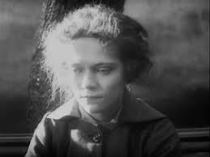 coquettish teenager and finally as an apparently suicidal mother. This is a stunning performance, never better than when she hesitatingly accepts the food offered to her by the old man. She was equally good as the doomed consumptive in Au bonheur des Dames (1930) but never went on to achieve the star status she seemingly deserved, with few further roles of any substance. Find out more at frenchfilms.org. If you think that such an avant garde film deserves an equally alternative accompaniment then the version on Vimeo here by musicians Paul Mercer and Bruch Bennett might be to your liking although I also like the version on You Tube with accordion accompaniment from Yegor Zabelov here.
coquettish teenager and finally as an apparently suicidal mother. This is a stunning performance, never better than when she hesitatingly accepts the food offered to her by the old man. She was equally good as the doomed consumptive in Au bonheur des Dames (1930) but never went on to achieve the star status she seemingly deserved, with few further roles of any substance. Find out more at frenchfilms.org. If you think that such an avant garde film deserves an equally alternative accompaniment then the version on Vimeo here by musicians Paul Mercer and Bruch Bennett might be to your liking although I also like the version on You Tube with accordion accompaniment from Yegor Zabelov here.
 Barbed Wire (Dir. Rowland V Lee, US, 1927) (67 mins) Pola Negri stars as Mona, the headstrong daughter of a French farmer at the onset of war in 1914. After her brother Andre
Barbed Wire (Dir. Rowland V Lee, US, 1927) (67 mins) Pola Negri stars as Mona, the headstrong daughter of a French farmer at the onset of war in 1914. After her brother Andre  is drafted her father is forced to turn the farm over to serve as a POW camp for German prisoners. Mona’s hatred of the Germans is compounded by the apparent death of Andre in battle. But gradually humanity overcomes her hatred, particularly when one of the POWs (Clive Brook) saves her from attack by a French soldier and the two gradually develop a closer relationship. A film set in war time rather than a war film, Barbed Wire is in many ways a surprisingly modern film. None of the characters are without their faults and there is a serious attempt to deal with such issues as nationalistic hatred and supposed collusion with an enemy. The ending is overly idealistic but
is drafted her father is forced to turn the farm over to serve as a POW camp for German prisoners. Mona’s hatred of the Germans is compounded by the apparent death of Andre in battle. But gradually humanity overcomes her hatred, particularly when one of the POWs (Clive Brook) saves her from attack by a French soldier and the two gradually develop a closer relationship. A film set in war time rather than a war film, Barbed Wire is in many ways a surprisingly modern film. None of the characters are without their faults and there is a serious attempt to deal with such issues as nationalistic hatred and supposed collusion with an enemy. The ending is overly idealistic but  no less moving for that (although even in 1927 British audiences still considered the film too pro-German). Pola Negri and Clive Brook both put in well rounded performances. Negri in particular is excellent as the farm girl, as far from the vamp image as she could get, but no less determined and self assured for all that. To find out more have a look at moviessilently.com. The You Tube version here isn’t of particularly good visual quality although it is watchable and comes with an OK live accompaniment on piano.
no less moving for that (although even in 1927 British audiences still considered the film too pro-German). Pola Negri and Clive Brook both put in well rounded performances. Negri in particular is excellent as the farm girl, as far from the vamp image as she could get, but no less determined and self assured for all that. To find out more have a look at moviessilently.com. The You Tube version here isn’t of particularly good visual quality although it is watchable and comes with an OK live accompaniment on piano.
 Noidan Kirot (aka Curse of the Witch) (Dir. Teuvo Puro, Fin, 1927) (89 mins) When Finnish small-holder Semo arrives back at his remote homestead with bride-to-be Selma, life looks idyllic. But not everything is as it should be. Selma learns from Semo’s blind sister of an ancient witch’s curse affecting the area, Then, when Semo is away, Selma is raped by one of a gang of itinerant lumberjack workers. Fearful of Semo’s reaction, she does not tell him, which sets off a spiral of suspicion and mistrust. Although billed as the first Finnish horror film, Noidan Kirot doesn’t really fit this bill being more a psychological melodrama with an element of the supernatural. However, the film is eminently watchable. The plotting is believable, particularly in Selma’s response to her assault and the supernatural element is well
Noidan Kirot (aka Curse of the Witch) (Dir. Teuvo Puro, Fin, 1927) (89 mins) When Finnish small-holder Semo arrives back at his remote homestead with bride-to-be Selma, life looks idyllic. But not everything is as it should be. Selma learns from Semo’s blind sister of an ancient witch’s curse affecting the area, Then, when Semo is away, Selma is raped by one of a gang of itinerant lumberjack workers. Fearful of Semo’s reaction, she does not tell him, which sets off a spiral of suspicion and mistrust. Although billed as the first Finnish horror film, Noidan Kirot doesn’t really fit this bill being more a psychological melodrama with an element of the supernatural. However, the film is eminently watchable. The plotting is believable, particularly in Selma’s response to her assault and the supernatural element is well  handled, focusing more on people’s beliefs than on actual ‘happenings’. The cinematography is stunning and some shots stand out as breathtaking, such as the witch seeing the reflection of his attacker in the cauldron or the wonderful water-borne wedding party. Additionally, Noidan Kirot is incredibly well preserved, beautifully tinted and looks like it could have been filmed yesterday, The only weak spot is the acting. With the
handled, focusing more on people’s beliefs than on actual ‘happenings’. The cinematography is stunning and some shots stand out as breathtaking, such as the witch seeing the reflection of his attacker in the cauldron or the wonderful water-borne wedding party. Additionally, Noidan Kirot is incredibly well preserved, beautifully tinted and looks like it could have been filmed yesterday, The only weak spot is the acting. With the  exception perhaps of the villain, the acting style is curiously old fashioned and overly theatrical for a film of its time, which was surprising given that other films made at the same time by this same studio have a much more naturalistic acting style. Oh, and its still a bit off-putting when the leading man is wearing more make-up than his leading lady! Available to watch here via the Finnish Film Archives. Although well sub-titled, the film does not have musical accompaniment. If it helps as you watch, just imagine what a master musician such as Stephen Horne could add to the stunning visuals and rising tension.
exception perhaps of the villain, the acting style is curiously old fashioned and overly theatrical for a film of its time, which was surprising given that other films made at the same time by this same studio have a much more naturalistic acting style. Oh, and its still a bit off-putting when the leading man is wearing more make-up than his leading lady! Available to watch here via the Finnish Film Archives. Although well sub-titled, the film does not have musical accompaniment. If it helps as you watch, just imagine what a master musician such as Stephen Horne could add to the stunning visuals and rising tension.
19 April
 For Ireland’s Sake (Dir. Sidney Olcott, US, 1914) (39 mins) Set late in the eighteenth century the film tells the story of Irish villagers rebelling against British occupation. When Marty O’Sullivan (Jack Clark), a young Irish blacksmith who forges pikes which are used as weapons, is spotted by British Soldiers he evades capture thanks to the quick thinking of his sweetheart Eileen (Gene Gauntier). When they are both eventually caught, escape comes with the aid of the local
For Ireland’s Sake (Dir. Sidney Olcott, US, 1914) (39 mins) Set late in the eighteenth century the film tells the story of Irish villagers rebelling against British occupation. When Marty O’Sullivan (Jack Clark), a young Irish blacksmith who forges pikes which are used as weapons, is spotted by British Soldiers he evades capture thanks to the quick thinking of his sweetheart Eileen (Gene Gauntier). When they are both eventually caught, escape comes with the aid of the local  priest. In 1910, the New York based Kalem Film Company became the first American movie studio to travel outside the country to make films on location, with a production unit arriving in Ireland to make a string of successful films aimed at the sizeable Irish-American community back home. The films were so successful, perhaps the best known being The Colleen Bawn (1911), that the company was informally known as O’Kalem. Director Olcott along with writer, director, and actress Gene Gauntier left Kalem in 1912, forming their own Gene Gauntier Feature Players Company through which they
priest. In 1910, the New York based Kalem Film Company became the first American movie studio to travel outside the country to make films on location, with a production unit arriving in Ireland to make a string of successful films aimed at the sizeable Irish-American community back home. The films were so successful, perhaps the best known being The Colleen Bawn (1911), that the company was informally known as O’Kalem. Director Olcott along with writer, director, and actress Gene Gauntier left Kalem in 1912, forming their own Gene Gauntier Feature Players Company through which they continued to make pictures on location in Ireland. For Ireland’s Sake was their last production together, with the two splitting shortly after for reasons as yet unknown, and was notable for a number of end-of-an-era reasons. The increasingly anti-British theme of Olcott’s films was attracting growing reticence from the authorities in Ireland to continue film-making
continued to make pictures on location in Ireland. For Ireland’s Sake was their last production together, with the two splitting shortly after for reasons as yet unknown, and was notable for a number of end-of-an-era reasons. The increasingly anti-British theme of Olcott’s films was attracting growing reticence from the authorities in Ireland to continue film-making  co-operation, and once war broke out in Europe it would come to a complete halt. The Kalem company was brought out by 1917, Gauntier (Image, right) had retired by 1920 (another largely forgotten woman pioneer of silent film – see here ) and Olcott had also gone soon afterward. In style too, things were changing. Shorts like For Ireland’s Sake were increasingly giving way to feature length films while the film’s directorial and acting style must already have begun to feel dated even for 1914. Nevertheless, For Ireland’s Sake remains an interesting way-point in the evolution of silent film. Find out more at moviessilently.com. The screening here comes from the Irish Film Institute‘s IFIPlayer, on which you can also watch a selection of other Kalem and Olcott/Gauntier films.
co-operation, and once war broke out in Europe it would come to a complete halt. The Kalem company was brought out by 1917, Gauntier (Image, right) had retired by 1920 (another largely forgotten woman pioneer of silent film – see here ) and Olcott had also gone soon afterward. In style too, things were changing. Shorts like For Ireland’s Sake were increasingly giving way to feature length films while the film’s directorial and acting style must already have begun to feel dated even for 1914. Nevertheless, For Ireland’s Sake remains an interesting way-point in the evolution of silent film. Find out more at moviessilently.com. The screening here comes from the Irish Film Institute‘s IFIPlayer, on which you can also watch a selection of other Kalem and Olcott/Gauntier films.
 In Spring (Dir. Mikhail Kaufman, USSR, 1919) (54mins) In Spring is more a cinematic poem than a documentary, celebrating the arrival of spring in nature as well as a new life in a society. With the first use of hidden camera it also offers a rare glimpse on everyday life in Soviet
In Spring (Dir. Mikhail Kaufman, USSR, 1919) (54mins) In Spring is more a cinematic poem than a documentary, celebrating the arrival of spring in nature as well as a new life in a society. With the first use of hidden camera it also offers a rare glimpse on everyday life in Soviet 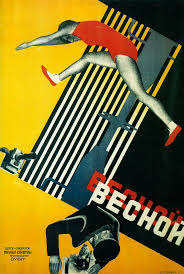 Ukraine during the New Economic Policy and the Soviet assimilation programme. In Spring was long considered a lost film until a copy was rediscovered in an Amsterdam film archive in 2005. Mikhail Kaufman’s reputation has long been overshadowed by that of his more well known brother Dziga Vertov. Most of the credit for the era defining classic of montage cinema Man With A Movie Camera (1929) goes to Vertov but in reality the film was the work of three people, director Vertov, editor Elizaveta Svilova and cameraman Kaufman. However, as a result of creative differences while working on the film, Kaufman decided to go his own way and his debut film as director and cameraman was In Spring. The film is every bit as striking as Man With A Movie Camera but with a more lyrical feel and is perhaps even more beautifully shot. Find out more at wikipedia.org There is a version of the film here, with a somewhat conventional (albeit a bit uninspiring) piano accompaniment. Alternatively, if you want a modern electronic musical interpretation, try this (although beware, when the film finishes at around 61 minutes, it starts over again, in reverse in an increasingly speeded up format!! I’ve no idea why! But its still a great film.)
Ukraine during the New Economic Policy and the Soviet assimilation programme. In Spring was long considered a lost film until a copy was rediscovered in an Amsterdam film archive in 2005. Mikhail Kaufman’s reputation has long been overshadowed by that of his more well known brother Dziga Vertov. Most of the credit for the era defining classic of montage cinema Man With A Movie Camera (1929) goes to Vertov but in reality the film was the work of three people, director Vertov, editor Elizaveta Svilova and cameraman Kaufman. However, as a result of creative differences while working on the film, Kaufman decided to go his own way and his debut film as director and cameraman was In Spring. The film is every bit as striking as Man With A Movie Camera but with a more lyrical feel and is perhaps even more beautifully shot. Find out more at wikipedia.org There is a version of the film here, with a somewhat conventional (albeit a bit uninspiring) piano accompaniment. Alternatively, if you want a modern electronic musical interpretation, try this (although beware, when the film finishes at around 61 minutes, it starts over again, in reverse in an increasingly speeded up format!! I’ve no idea why! But its still a great film.)
18 April
 L’Hirondelle et la Mésange (aka The Swallow and the Titmouse) (Dir. Andre Antoine, Fr, 1920) (80mins) One of my all time favourite silent films, this was shot entirely on location on the waterways of Flanders, the story is set on two canal barges, L’Hirondelle (The Swallow) and La Mesange (The Titmouse). The drama involves the tensions between the barge captain and the pilot whom he has hired to steer the coal-bearing ships to areas in France devastated by the war, but who sullenly lusts after both the captain’s wife and the contraband they are smuggling.
L’Hirondelle et la Mésange (aka The Swallow and the Titmouse) (Dir. Andre Antoine, Fr, 1920) (80mins) One of my all time favourite silent films, this was shot entirely on location on the waterways of Flanders, the story is set on two canal barges, L’Hirondelle (The Swallow) and La Mesange (The Titmouse). The drama involves the tensions between the barge captain and the pilot whom he has hired to steer the coal-bearing ships to areas in France devastated by the war, but who sullenly lusts after both the captain’s wife and the contraband they are smuggling.  Never released upon its completion on the grounds that it was not commercially viable, the unedited film lay in the archives of Cinémathèque Française until the early 1980s when the perfectly preserved footage was edited into a completed film using Gustave Grillet’s script and the director’s detailed notes as a guide. Read our (with spoilers) review here or find out more at silentfilm.org. The version screened here on You Tube comes with an adequate soundtrack although if you ever get the chance go see it with live accompaniment from Stephen Horne and Elizabeth Jane Baldry, its magical. Additionally, although there are English translations of the French inter-titles they run a bit out of sync with the film. But it doesn’t matter too much, just sit back and soak up the visuals and the almost imperceptibly mounting tension.
Never released upon its completion on the grounds that it was not commercially viable, the unedited film lay in the archives of Cinémathèque Française until the early 1980s when the perfectly preserved footage was edited into a completed film using Gustave Grillet’s script and the director’s detailed notes as a guide. Read our (with spoilers) review here or find out more at silentfilm.org. The version screened here on You Tube comes with an adequate soundtrack although if you ever get the chance go see it with live accompaniment from Stephen Horne and Elizabeth Jane Baldry, its magical. Additionally, although there are English translations of the French inter-titles they run a bit out of sync with the film. But it doesn’t matter too much, just sit back and soak up the visuals and the almost imperceptibly mounting tension.
 The Goat (Dir. Buster Keaton/Mal St Clair, US, 1921) ( 27mins) Buster Keaton is probably best remembered now for his feature length films such as The General or Steamboat Bill Jr, but his earlier shorts are no less enjoyable and a fine example is The Goat, in which Keaton, already on the run from the cops, is then mistaken for murderer Dead Shot Dan (portrayed, incidentally, by Keaton’s co-director Mal St. Clair). Having eluded the previous bunch of cops, he’s now being
The Goat (Dir. Buster Keaton/Mal St Clair, US, 1921) ( 27mins) Buster Keaton is probably best remembered now for his feature length films such as The General or Steamboat Bill Jr, but his earlier shorts are no less enjoyable and a fine example is The Goat, in which Keaton, already on the run from the cops, is then mistaken for murderer Dead Shot Dan (portrayed, incidentally, by Keaton’s co-director Mal St. Clair). Having eluded the previous bunch of cops, he’s now being  pursued by ill-tempered, cigar chomping, heavyweight detective Joe Roberts who’s hot on his trail…or is he? This two reeler is an almost relentless chase sequence with a myriad of brilliant but punishing physical stunts and as such is a pleasure to behold. Watch out especially for Keaton’s perfectly judged escape from the dinner party while the sequence around the elevator is a joy to behold. A delightful, fast-moving film. Find out more at wikipedia.org. There are multiple versions of The Goat on You Tube with alternative scores but the one here via Daily Motion has a nice jaunty accompaniment.
pursued by ill-tempered, cigar chomping, heavyweight detective Joe Roberts who’s hot on his trail…or is he? This two reeler is an almost relentless chase sequence with a myriad of brilliant but punishing physical stunts and as such is a pleasure to behold. Watch out especially for Keaton’s perfectly judged escape from the dinner party while the sequence around the elevator is a joy to behold. A delightful, fast-moving film. Find out more at wikipedia.org. There are multiple versions of The Goat on You Tube with alternative scores but the one here via Daily Motion has a nice jaunty accompaniment.
 Afgrunden (aka The Abyss or The Woman Always Pays) (Dir. Urban Gad, Dk, 1910) (38mins) Denmark’s Asta Nielsen was probably the first big international film star, so famous in fact that she became known simply as Die Asta (The Asta). Making her name first on the stage, Afgrunden marked Nielsen’s film debut. In it she plays Magda, a piano teacher, who soon after meeting a mild mannered vicar, is invited by his parents to holiday with them. But while on holiday Magda is lured away by the attraction of a traveling circus and in particular Rudolf, one of the performers. But Rudolf has eyes for
Afgrunden (aka The Abyss or The Woman Always Pays) (Dir. Urban Gad, Dk, 1910) (38mins) Denmark’s Asta Nielsen was probably the first big international film star, so famous in fact that she became known simply as Die Asta (The Asta). Making her name first on the stage, Afgrunden marked Nielsen’s film debut. In it she plays Magda, a piano teacher, who soon after meeting a mild mannered vicar, is invited by his parents to holiday with them. But while on holiday Magda is lured away by the attraction of a traveling circus and in particular Rudolf, one of the performers. But Rudolf has eyes for 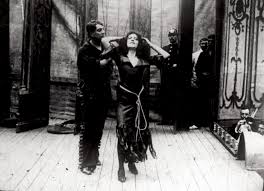 more than just Magda and soon tragedy will ensue. Nielsen was noted for bringing a far more naturalistic style of acting to film work but she also had a flair for the erotic, as her dance routine in Afgrunden amply demonstrates. Find out more at acinemahistory.com. The screening here comes from the Danish Film Institute but it lacks any musical accompaniment. If you like modern electronic scores with your silent films there is a version here on You Tube with excellent accompaniment by Jiavu. Unfortunately the surviving print of Afgrunden has some serious nitrate damage although, ironically, not in the dance scene, which was recovered from the archives of the Swedish Censor after it was cut from the version released in that country (and why would the censors keep all the excised material? Echoes of Cinema Paradiso?). Anyway, enjoy.
more than just Magda and soon tragedy will ensue. Nielsen was noted for bringing a far more naturalistic style of acting to film work but she also had a flair for the erotic, as her dance routine in Afgrunden amply demonstrates. Find out more at acinemahistory.com. The screening here comes from the Danish Film Institute but it lacks any musical accompaniment. If you like modern electronic scores with your silent films there is a version here on You Tube with excellent accompaniment by Jiavu. Unfortunately the surviving print of Afgrunden has some serious nitrate damage although, ironically, not in the dance scene, which was recovered from the archives of the Swedish Censor after it was cut from the version released in that country (and why would the censors keep all the excised material? Echoes of Cinema Paradiso?). Anyway, enjoy.
